Vol 21 | No 3 | 2024



Vol 21 | No 3 | 2024


RSG Landbou word elke Vrydagoggend om 5:25 vm. en Saterdae om 11:45 vm. uitgesaai.
Tydens ons programme maak ons kennis met innoveerders, boere-planmakers, asook diegene aan die voorpunt van landbou-tegnologie en navorsing. Maak gerus kontak en laat jou stem gehoor word. Ek nooi jou graag uit om stories van hoop en inspirasie met my te deel. Stuur gerus wenke en idees na Eloise Pretorius | eloise.pretorius@westerncape.gov.za


“Sien” jou binnekort op die radio!



Vir meer inligting
Meer inligting oor die programreeks is beskikbaar op www.rsg.co.za en die uitsendings kan ook afgelaai word.


Potgooie Vir aflaai van potgooie, skandeer die kode of besoek www.rsg.co.za/ rsg/page_id344/
Nou ook beskikbaar op die RSG toep!


by Lindè Govender

economic growth through creating employment and in doing so uplifting their communities. With this initiative the Department recognises the hard work, perseverance and dedication of so many women who give hope and encouragement to others.
TThis edition of AgriProbe holds a special place for me as the newly appointed CFO as it also marks my very first contribution to this fantastic publication.
As CFO, I focus on the numbers, running an efficient and effective finance operation, maintaining the highest level of good governance and minimising risk while striving to strike a balance between compliance, service delivery and value addition within the legislative frameworks of government.
The fact that we, as a government department, can contribute so greatly to making the sector thrive is a tangible success story. Our exceptional expertise enables progress of the sector as a leading contributor to economic growth in the Western Cape, despite the constrained economic climate we operate in.
Considering the vast number of challenges the Department faces, which include budget reductions, we have to be innovative and forwardthinking in our approach, not only in service delivery but also in how we as the finance team support and advise managers and staff within a regulated environment.
This edition of AgriProbe features a significant contribution from female authors, reflecting the theme of women taking the lead, especially in celebration of Women’s Month. The outstanding stories of the Women Entrepreneur Awards 2024 showcase the strides women are making in the agricultural sector and how they are driving
Similarly, it was heartening to see the recognition the rooibos industry bestowed upon the smallholder rooibos producers in Clanwilliam, and with biosecurity being a major risk and a priority of our Department, it was intriguing to read about Orf, a highly contagious virus affecting sheep and goats worldwide that residents should be made aware of.
As a regular consumer of olive products, the significant growth in South Africa’s olive sector over the past few decades is commendable. Despite relatively low production volumes compared to major Mediterranean producers, South Africa has captured a spot on the global olive oil market.
Agriculture is a science, and the Western Cape agricultural sector is fortunate to have a wealth of data and information on hand. Having completed the greatest number of evaluations in the whole of the Western Cape Government, the 2023 Western Cape Agricultural Sector Profile presents the sector’s performance and highlights key trends, making it a worthy read for anyone keen on using research for evidence-based decision-making.
Thank you for your continued support and engagement with AgriProbe. I hope you enjoy it as much as I do.
#ForTheLoveOfAgriculture AP




EDITORIAL
Setting the scene
Women taking the lead
MINISTERIAL
A job and food on the table
DIARY AND EVENTS
Symposium highlights from Mexico
2024 Annual Prestige Agri-Awards underway
Inaugural Rooibos Awards showcase industry excellence
NEWS SNIPPETS
Elsenburg Agricultural Institute wins its 37th Rugby Week Title
ECOS client training held at Elsenburg
Empowering Women in Agriculture
HUMAN
Human
ECONOMIC NEWS
High Quality, High Potential – South Africa’s olive oil sector on the rise
Africa Day Business Seminar –Celebrations or a business cry in the wilderness?
Western Cape Agricultural Sector Profile 2023
The road to developing the 2025 –2030 Strategic Plan
We know that the Western Cape is in many ways a unique province, but did you know…
TAKING OUR SERVICES OUT THERE Radio verskuif die grense
OneHealth, One Welfare Animal Welfare Workshop: Insights from a fascinating Donkey Workshop
Provincial Veterinary Laboratory re-opens with enhanced capacity
ORF – Why should we know about it?

OUR NATURAL RESOURCES

Towards Energy Resilience
ELSENBURG JOURNAL
South Africa’s Fynbos cut and dried flowers trade performance
Climate change and its potential effects on animal production: Local studies on sheep and beef cattle to mitigate impact
Heat stress in sheep: The potential of natural tree shade provision and breed selection as mitigatory measures

PUBLISHING TEAM
Publisher: Erika Alberts
Layout & design: Christopher Robin Design
Copy editor: Aletta Pretorius-Thiart
Financial director: Pat Botha
For publishing enquiries, e-mail: media@mlpmedia.co.za
The South African olive oil industry has grown significantly, emerging as a key player in the global market. Despite challenges and fierce competition, this industry has shown remarkable resilience. By focusing on strategic planning, research and capitalising on international recognition, South Africa can further strengthen its position as a leading exporter of premium olive oil. Continued support and initiatives are essential to drive economic growth and create jobs in this thriving industry. Read the full report on page 26.
COVER
Conceptual cover designed by Christopher Robin Design.
Cover image © Luigi Giordano

EDITOR
Mary James (021 808 5008) mary.james@westerncape.gov.za
CHAIRPERSON
Dr Ilse Trautmann (021 808 5012) ilse.trautmann@westerncape.gov.za
SECRETARIAT
Gizelle van Wyk (021 808 5022) gizelle.vanwyk@westerncape.gov.za
EDITORIAL COMMITTEE
Arie van Ravenswaay (021 808 5085) arie.vanravenswaay@westerncape.gov.za
Ashia Petersen (021 808 5010) ashia.petersen@westerncape.gov.za
Daniel Johnson (021 483 3261) daniel.johnson@westerncape.gov.za
John Constable (021 808 7763) john.constable@westerncape.gov.za
Dr Lesley van Helden (021 808 5017) lesley.vanhelden@westerncape.gov.za
Riaan Nowers (021 808 5194) riaan.nowers@westerncape.gov.za
Vusumzi Zwelendaba (021 808 5226) vusumzi.zwelendaba@westerncape.gov.za
Sandile Mkhwanazi (021 808 7034) sandile.mkhwanazi@westerncape.gov.za
Juan de Lora (021 808 5383) juan.delora@westerncape.gov.za
From the desk of the Western Cape Minister of Agriculture, Economic Development and Tourism Dr Ivan Meyer (left). Compiled by Daniel Johnson.



SDid you know?
From the vineyards to the cellar, from the olive orchards to the restaurant, women play vital roles at Gabriëlskloof. For more information, visit: www.gabrielskloof.co.za
South Africa has entered an exciting new phase of its development. We now have a Government of National Unity, which lays the platform for improved cooperation between all three spheres of government. This is good news for agriculture, which has a footprint in every town in South Africa. The spirit of hope and enthusiasm to set our country on a new trajectory must be embraced and propel us towards upping our contribution to building a united, responsive and prosperous agricultural sector in balance with nature.
Achieving our vision depends on the extent to which we address one of South Africa’s most pressing challenges: unemployment.
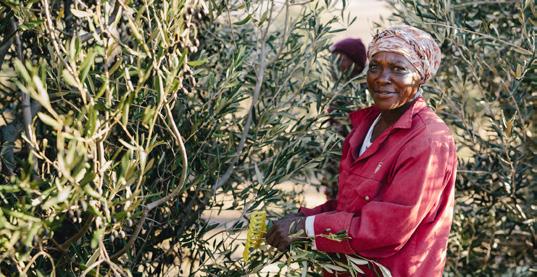

Gabriëlskloof Extra Virgin Olive Oil is a blend of first-press oils from five different varieties, grown, pressed and bottled on the farm.
It is against this background that I have set my priorities for the next five years. My new priorities will focus on supporting the agricultural and business sectors, food security, and market access. I refer to my priorities as ABFM.

My priorities capture what will keep me awake at night for the next five years. My laser-sharp focus on jobs holds my priorities together.
ABFM is underpinned by the Western Cape Government’s Growth for Jobs strategy, which seeks to create a R1 trillion provincial economy by 2035.
To do so, we will have to triple Western Cape exports by 2035 to reach R450 billion and increase private sector investment to 20% of the GDP (R200 billion).
Within the engine room of our breakout economic plan, Growth for Jobs are entrepreneurs, especially women entrepreneurs like the ones we just celebrated for participating in and winning the Department’s Women in Agriculture Entrepreneur competition.
The competition celebrates what is possible when we care enough to work actively to advance our women and not go back to a world that devalues their contribution.
My slogan for this term is a Job and Food on the Table
Every agriculture programme should ensure a job and food on your table
Every programme with the Department of Economic Development and Tourism should be geared towards a job and putting food on your table.



Agriculture is the engine room of job creation, a key driver of economic growth, and plays a crucial role in developing our rural economy.
I appeal to each one of you to join me in ensuring that every household in the Western Cape has a job and food on the table
#ForTheLoveOfAgriculture AP
For more information, contact Daniel Johnson: daniel.johnson@westerncape.gov.za
by Dr Jacques van Zyl

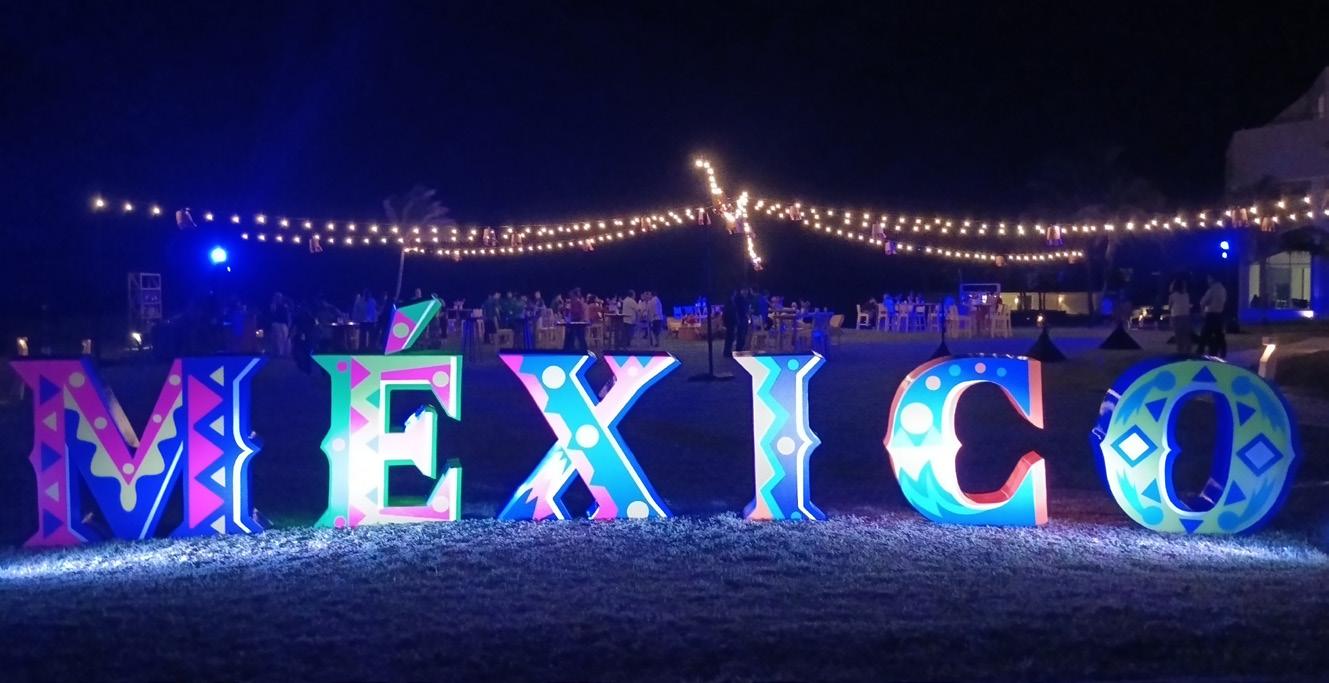
EEnd October 2023, a study tour was undertaken to Cancún, Mexico, to take part in various meetings and events that were organised around the International Symposium on Advance Technologies and Management for Innovative Greenhouses (Greensys 2023), the IV International Society for Horticultural Science and the Food and Agriculture Organisation of the United Nations (FAO).
The International Symposium on Advanced Technologies and Management for Innovative Greenhouses and the IV International Symposium on Organic Greenhouse Horticulture were organised according to 34 technical themes of which the following were of special interest: Climate control and modelling Computational Fluid Dynamics in controlled environment horticulture


Fertigation, water management
Greenhouse systems and design
Growing media, hydroponics, aquaponics
Lighting technology
Sustainable greenhouse systems and environmentally friendly technologies
Censors, automation and robotics in greenhouses
Vertical farming
Environmental performance of organic greenhouse farming systems
Sustainable irrigation management of organic cultivation
Urban organic farming and food security
The symposia highlighted that closed growing systems are the solution to lower the emission of nutrients from glasshouse horticulture. These systems can however cause problems like the accumulation
These events brought together 255 scientists, researchers, technicians and other professionals to present their scientific and technological innovations in greenhouse horticulture and other controlled environment horticultural systems, to share their ideas and knowledge and discuss the state-of-the-art technologies and future perspectives for the controlled environment horticultural sector with emphasis on sustainability issues as well as the implementation of technologies into the field of production. There were 170 oral and 94 poster presentations delivered. Learn more!
Scan the QR code or visit shorturl.at/nYa65
of sodium and chlorine, or other ions and can lead to an unbalanced nutrient solution. The development of standards for water quality and nutrient input are thus essential. Generally, the input of ions by means of the water and fertilisers should be equal to the plant use or uptake. The acceptable water quality is determined by the uptake capacity of the crop and the maximum acceptable concentration in the root environment. If the maximum concentration in the input is bigger than the uptake concentration at maximum levels, partial leaching of the recirculating nutrient solution is required.


To mitigate the problems of water and nutrient losses, closed growing systems should be utilised more generally in South Africa where drain-to-waste systems are more commonly used.
However, in-soil planting greenhouse production should be seriously considered up to a point where producers have mastered some of the basic techniques of production under a protected environment due to the buffer that is provided by in-soil planting.
Workshops and meetings with the FAO have reiterated the view that producers who are new to production in greenhouses should start the process by planting in the
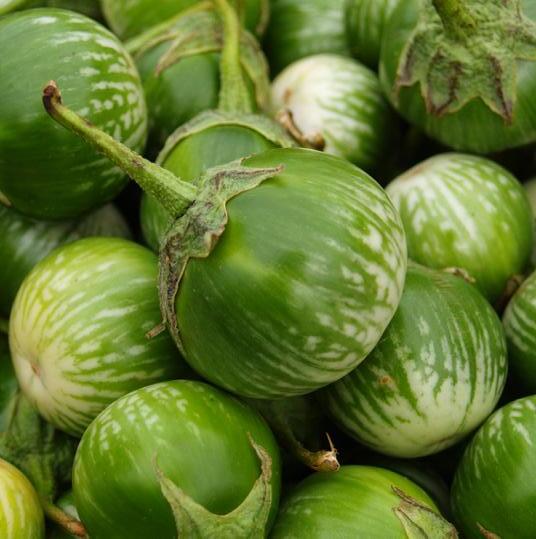
Thai eggplant can easily be distinguished from other popular eggplant varieties by its shape, size and stem.
soil in the greenhouses and then progress in time, depending on the success rate of production, to production in soilless conditions. The FAO was extremely interested in our project regarding nutrient and water use efficiency in greenhouses, as well as the future envisaged project of potato mini-tuber production in aeroponic conditions in greenhouses.

Meetings with scientists of the Ohio State University, Lithuanian Research Centre for Agriculture and Forestry and the Technological University of Cancún had a positive outcome as these institutions are interested in the nutrient recirculation research we are doing currently, as well as the envisioned aeroponics research planned for the future.
Pamasur, a farm near Temozón, was visited, as well as a research field at the premises of the Technological University of Cancún. Pamasur is one of the leading exporters of oriental vegetables in Mexico; this has allowed them to progressively expand their product catalogue and reach new export markets. At the Technological University of Cancún, Thai and graffiti eggplants are produced in coir under shade net with fertigation according to hydroponic standards.
Graffiti eggplants are purple with white stripes. The inner flesh is cream to pale white and has small, edible seeds. Graffiti eggplants are tender and smooth with a sweet and slightly fruity flavor when cooked.
The interaction with international scientists in Mexico once again reiterated that the research undertaken in South Africa regarding greenhouse production is on par with the rest of the world. AP
For more information, contact Dr Jacques van Zyl: jacques.vanzyl2@westerncape.gov.za
by Gatian Gabriel


TThe 2024 Western Cape Department of Agriculture (WCDoA) Prestige Agri-Awards kicked off at the Stellenbosch Agricultural Society’s Doornbosch Hall during April 2024. The intimate event, held to highlight the purpose and achievements of the competition, recognises various agricultural workers in the sector and the pivotal role they play. To launch the year’s competition a day before Freedom Day, as well as a few days before Worker’s Day, which celebrates agri-workers, was significant.
The 2023 winner, Vivian Jakobs from Crispy Farming (Du Toit Group), Witzenberg,
reflected on his achievement and his subsequent overseas trip. Vivian said: “You always think the grass is greener on the other side, but here it is much greener.”
Pieter van Zyl, General Manager for Procurement at the Shoprite Group, the headline sponsor of the competition, said the competition is to award and thank agricultural and rural workers, especially from the countryside. “Thank you to the Department for getting involved and we will help where we can,” said Pieter.
Darryl Jacobs, WCDoA DDG and acting HOD on this day, explained that the

Regulatory Services)
competition was started by Tannie Elsa (Elsa Jordaan, CEO, Hex Valley Table Grape Association) in 2002. “I want to thank everyone for the sacrifice and contribution in making this journey possible. To our agri-workers, our recognition of your partnership, advice and cooperation cannot be understated or underestimated. Thank you to you all and Shoprite for a long, continuous partnership.”
Dr. Elna von Schlicht, executive mayor of the Cape Winelands District Municipality, also commented that the competition is already 22 years old. “That is a huge milestone, and it shows it’s a success. Agriculture is one of the pillars of income in the Cape Winelands,” she said, and concluded that the competition was intended to acknowledge people working in the agricultural sector and to give agricultural workers recognition for who they are, where they come from and what they are to become.
“The competition is already 22 years old – a huge milestone.”
Ending with a vote of thanks, Jacqueline Pandaram, WCDoA Chief Director for Rural Development, thanked the audience and once again highlighted the importance of agricultural workers at large. “We cannot do this without you. We thank all our partners. We must never forget that this competition is about our agri-workers, we are recognising and thanking them.”
The competition’s winner for 2024 will be revealed at a gala ceremony, which is to be held on 2 November. AP
For more information, contact Deona Strydom: deona.strydom@westerncape.gov.za
by Robyn Carstens


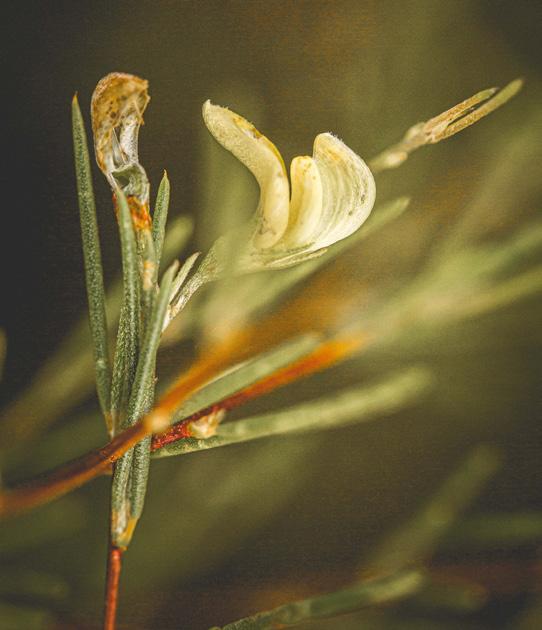
Since 1954, Rooibos Ltd has been a highly esteemed supplier of Rooibos and related items, exporting to over 50 countries globally.
Learn more!
Scan the QR code or visit rooibosltd.co.za
HHosted by the Western Cape Department of Agriculture (WCDoA) and Rooibos Limited, the inaugural Rooibos Awards took centre stage, celebrating the pinnacle of achievement and innovation within the Rooibos industry. The ceremony, held in April this year at the Clanwilliam Show Grounds Hall, cast the spotlight on the remarkable strides made by leaders and pioneers in the Rooibos community.


each other and stand out amongst others in the industry.
Spearheaded by Riana van Rensburg, agricultural adviser of the WCDoA, the awards aimed to recognise excellence while fostering sustainability and growth within the Rooibos sector.
During the event, Riana said the designation of the Rooibos Producer of the Year is an opportunity that was created to give up-and-coming farmers from the Cederberg a platform where they can compete against
It was an honour to have Dr Ruben Richards, the Executive Mayor of the Cederberg Municipality, do the official welcome at the gala event.
Also in attendance was Dr Mogale Sebopetsa, Department Head of the WCDoA. In his keynote address he acknowledged the opportunity to recognise the best producers and honour them for the good quality rooibos tea they produce and the significance of the awards to further promote excellence and growth within the Rooibos industry.

Emerging Rooibos Producer of the Year
Participants underwent rigorous evaluation in both theoretical and technical sections. Theoretical assessments encompassed various aspects, including the establishment of Rooibos businesses, industry challenges and plantation management. A specialised committee evaluated these submissions, while technical teams conducted on-site assessments to determine performance metrics.
Winners were announced across four distinguished categories:
Rooibos Producer of the Year
Nico Slinger of De Lille Boerdery claimed the coveted title, recognised for his exceptional production exceeding 1 250kg of Rooibos tea annually. Gerrie Koopman from Sonderwaterkraal in Clanwilliam emerged as the runner-up in this category.
Maria Koopman from SORCO at Kleinvlei secured the top spot in this category, demonstrating outstanding performance in producing less than 1 250kg of Rooibos tea per year. Cheslin Koopman, also from SORCO at Kleinvlei, earned recognition as the runner-up.
The Sedervlei Rooibos Farming Primary Cooperative, represented by Boeta Ravel, clinched this prestigious title. The cooperative’s dedication to sustainable practices stood out, with the Cederberg Feeds Primary Cooperative securing the runner-up position.
Wupperthal Original Rooibos Primary Agricultural Cooperative, represented by Barend Salomo, was hailed for its exemplary commitment to sustainable agri-processing practices.

Each category winner received a cash prize of R4 000, with runners-up receiving R3 000 each. The prize money was sponsored by Kaap Agri, Agri Expo, TopQualiTea, Land Bank, Nardouwsberg Farmers’ Association, Rooibos LTD and Le Vonja Farm.
Additionally, the Rooibos Producer of the Year was awarded 1kg of Rooibos tea seeds valued at R5 000.
The competition provided valuable insights into the industry’s dynamics. Notable findings included the critical role of recordkeeping in successful cultivation, the impact of plantation establishment on production and the significance of organic cultivation in securing better prices for producers.



In the Emerging Rooibos Producer category, emphasis was placed on cooperation, capacity development and effective marketing strategies. Despite varying farm sizes, a common thread of business acumen and market understanding emerged, emphasising the importance of production management.
The success of the competition underscored the uniqueness of Rooibos farming in the Cederberg region and its growth potential. Feedback from the competition will serve as a roadmap for producers, facilitating continuous improvement and ensuring the delivery of high-quality products to market.
As the Rooibos Awards establish themselves as an annual event, the industry looks forward to further advancements, innovation and collaboration, bolstering Rooibos’ position as a global leader in the beverage industry. AP
For more information, contact Robyn Carstens: robyn.carstens@westerncape.gov.za
By Sandile Mkhwanazi


EElsenburg Agricultural Training Institute once again lifted the South African Agricultural Colleges Rugby Week Trophy.
After a week of spirited rugby with visiting agricultural colleges from the rest of the country, the coveted trophy was fiercely contested between Grootfontein Agricultural Developmental College from Middelburg in the Eastern Cape and the host, Elsenburg.
During the Gala Dinner, Darryl Jacobs, the Deputy Director General of the
Department and Acting Principal of the College, welcomed and thanked the colleges for their attendance and sportsmanship. He acknowledged the sponsors of the tournament, Atlantic Fertilisers and Dura Equipment Sales, for their support and relationship with the Agricultural Colleges. He also thanked the College kitchen staff and the sport committee for organising the event for a second year in a row.



The guest speaker on the day, Charles Beukes, a former Director and Executive member of Athletics South Africa, encouraged the players to be active citizens and to remember that by representing their colleges they are role models for their peers.
On the final day of the Rugby Week, the host lifted their 37th trophy in the presence of Dr Ivan Meyer, the Western Cape Minister of Agriculture, Economic Development and Tourism, Dr Mogale Sebopetsa, WCDoA Head of Department,
and Darryl Jacobs.
Len Conradie, Elsenburg Agricultural Institute coach, noted that the standard of rugby during the week was high, with some tight matches that could easily have had different results.
“Grootfontein gave us a good run in the final. We were very lucky to win the match, and it felt even better that we shared the trophy for Best Game of the Week with them,” he said.
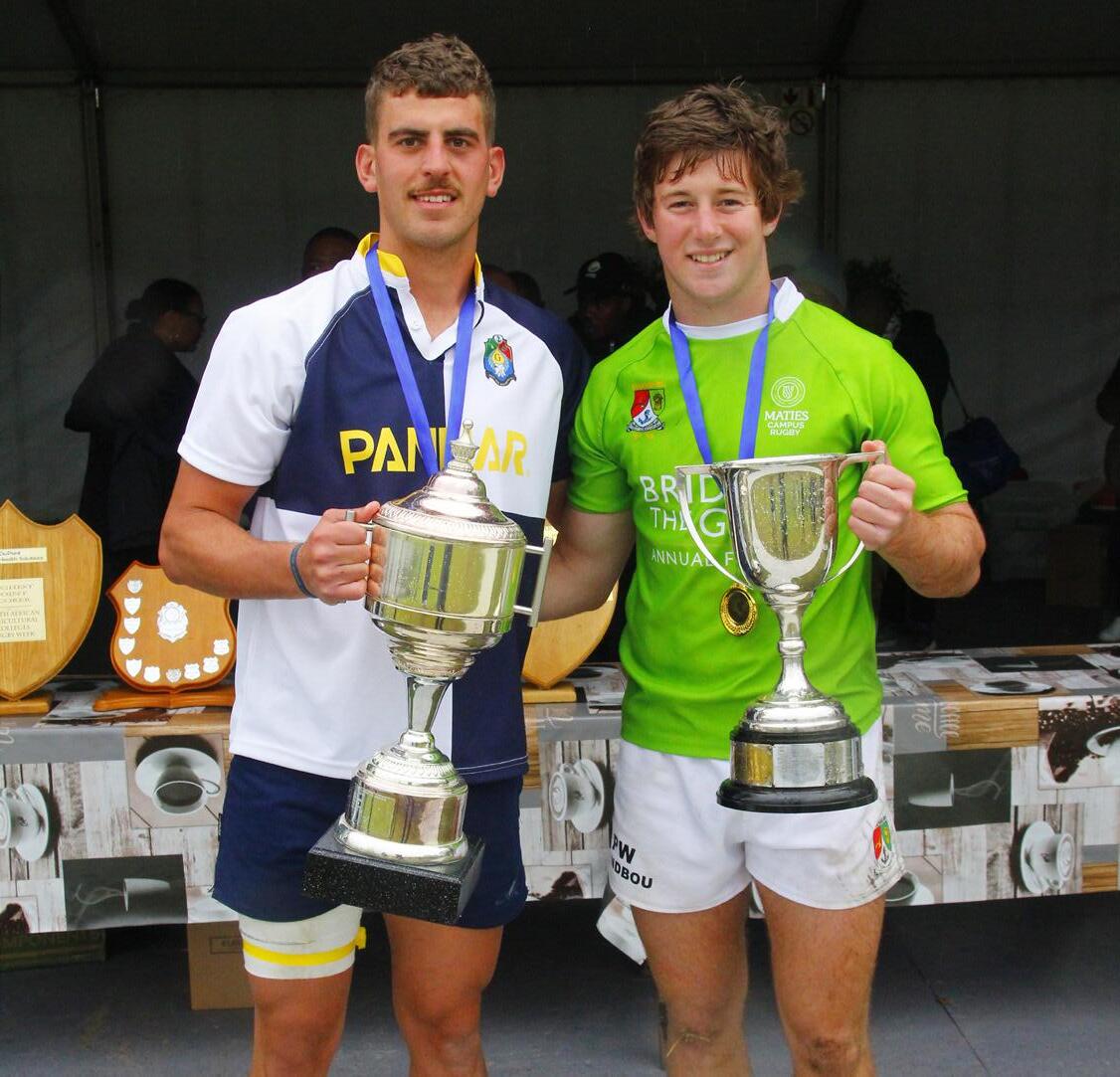
The road to the final for Elsenburg Agricultural Institute:
Day 1: Elsenburg 57 and Cedara 3
Day 3: Elsenburg 76 and Taung 6
Final match: Elsenburg 20 and Grootfontein 6
Below are some of the trophies awarded on the final day.
Joe Venter Trophy – Best forward player: Bango Sodinga (Tsolo)
Pannar Trophy – Best backline player: Jaco Wiehann (Elsenburg)
Du Pont Trophy – Player scoring the most points: Enric Taljaard (Grootfontein)
Corteva Trophy – Team with the most tries: Elsenburg
Willie van Zijl Trophy – Two teams that played the best game: Elsenburg and Grootfontein
Boland Bank Trophy – Team playing the most constructive rugby: Grootfontein
Piet de Jager Trophy – Third place: Tsolo
Kohler Motors Trophy – Runners up: Grootfontein
IPJ Du Plessis Trophy – Winners of the tournament: Elsenburg
For more information, contact Sandile Mkhwanazi: sandile.mkhwanazi@westerncape.gov.za
By Lerato Nedzanani
IIn February this year, the first client training session for the Export Certificate Office System (ECOS) took place at Elsenburg. This initiative, led by Dr Lerato Nedzanani and Dr Vincent Henwood, aimed to equip clients with the skills needed to use ECOS effectively.

The programme covered a range of topics relevant to using ECOS for exports. Dr Henwood provided an overview of the system’s features and explained its functionalities. Training also covered fee processing, inspection application procedures and certification processes. This gave participants a well-rounded understanding of how to use ECOS throughout the export journey.
Discussions also touched on interprovincial online movement permits; a move seen as beneficial for the dairy industry. This focus on paperless systems aligns with environmental sustainability goals. Additionally, the training explored implementation plans and potential improvements to ECOS. Client feedback was encouraged to make the platform more userfriendly and efficient.
A lunch sponsored by the Netherlands Embassy fostered a collaborative environment, allowing clients and stakeholders to network and share knowledge. The training concluded with participants gaining the necessary skills to navigate ECOS effectively. This initiative is a positive step towards streamlining export processes for all involved.

Read more! shorturl.at/ ON8vJ
ALL clients that export a product or a commercial live animal must register on Ecert and ECOS if they want to export from the Western Cape. If you would like to access the system to see information about your company, you will need to do the following in preparation: Follow the getting started guideline on shorturl.at/o1UAu and complete steps one and two of the guide:
1. register as a new user
2. register a business
For more information on this process visit: shorturl.at/7xCi9 and shorturl.at/ gDwRr AP
For more information, contact Lerato Nedzanani: lerato.nedzanani@westerncape.gov.za
by Mary James and Douglas Chitepo



TThe agricultural sector is a vital pillar of the Western Cape’s economy, and women within this sector are playing an increasingly significant role. The 2024 Western Cape Women Entrepreneur Awards (WEA), hosted by the Western Cape Department of Agriculture (WCDoA) in August at the historic Stellenbosch Town Hall, provided a fitting platform to celebrate the remarkable contributions of women in this field.
This year’s event, held under the inspiring theme “Invest in Women: Accelerate Progress and Achievement of Gender Equality and the Empowerment of Women”, underscored the essential role of women in driving agricultural innovation and fostering economic growth.

The WEA is more than just an awards ceremony; it is a cornerstone initiative that aligns with the national Women Empowerment Strategy. This programme is dedicated to recognising and promoting the involvement of women, young women and women with disabilities in agriculture, land reform and rural development. By shining a spotlight on these trailblazers, the awards seek to inspire future generations of women to pursue careers in agriculture and contribute to food security and rural economic development.
This year, the competition attracted a number of entries across the categories, showcasing the diverse and innovative ways in which women are transforming the agricultural landscape. The rigorous adjudication process, which evaluates entries on criteria such as innovation, economic sustainability, compliance to legislative and financial frameworks and community impact, resulted in the selection of winners across multiple categories, each representing excellence in their respective fields.
The 2024 Western Cape Women Entrepreneur Awards proudly presented the following winners:
Best Female Worker: Anchen de Peers (Baakensrug Farm, Beaufort West)
Best Smallholder Producer: Sharleen Bodenham (Kauthar’s Broiler Chickens, Hopefield)
Best Subsistence Producer: Lillian Masebenza (Mhani Gingi Social Entrepreneurial Network)
Best Commercial Producer: Berene Damons (Tesselaarsdal Wines)
Best Agri-Processor: Liebre Jacobs (FruitLips)
Best Exporter: Marilyn Siegels (Nitaflo (Pty) Ltd, Grabouw)
Special Award (smallholder category): Joandra Greegory (Our Poultry Place (Pty) Ltd, Kraaifontein) and Sheena Paulus (Tri Toad (Pty) Ltd, Philippi)
Ministerial Award: Natasha Williams (Natasha Signature Wines, Overberg)
These extraordinary women exemplify the innovation, resilience and entrepreneurial spirit needed to succeed in agriculture. Their achievements not only contribute to their local communities but also have a broader impact on the economy of the province and the nation. Through their work, these women are living proof of how investing in women leads to significant progress in gender equality and economic empowerment.

The Special Award is a distinctive category, where the Head of the Department personally selects winners from the pool of entries. This year, two exceptional smallholder farmers were honoured in this category: Joandra Greegory of Our Poultry Place (Pty) Ltd in Kraaifontein, and Sheena Paulus of Tri Toad (Pty) Ltd in Philippi. Both women have made tremendous strides in their journey from smallholder projects to emerging commercial producers, reflecting the transformative power of determination and support.
Speaking at the event, Dr Ivan Meyer, Western Cape Minister of Agriculture, Economic Development and Tourism, highlighted the critical importance of supporting women in agriculture. “Women are the backbone of our rural communities. By investing in their potential, we are not only promoting gender equality, but also ensuring the sustainable growth of our agricultural sector,” he remarked. Dr Meyer’s words resonate with the overarching goal of the WEA: to foster an environment where women can thrive, innovate and lead in agriculture.

The timing of the awards during Women’s Month adds further significance to the event. It serves as a powerful reminder of the Western Cape’s unwavering commitment to advancing gender equality and creating opportunities for women in agriculture. By recognising the vital role women play in this sector, the awards contribute to the broader movement towards a more inclusive and equitable society.
The 2024 Western Cape Women Entrepreneur Awards were not just a celebration, but a call to action. They reminded everyone in the agricultural sector and beyond of the importance of investing in women as a strategy for sustainable development and economic growth. As these women continue to make strides in their respective fields, they pave
“The 2024 Western Cape Women Entrepreneur Awards were not just a celebration but a call to action.”
the way for future generations, ensuring that the agricultural sector remains vibrant, innovative and inclusive.
The WCDoA would like to extend our gratitude to all our partners and adjudication team for their unwavering commitment and dedication to this women-led initiative.
For those who were unable to attend the event, full videos of the WEA 2024 winners are available online, offering a closer look at the inspiring stories behind these remarkable women’s successes. To view these videos, please visit: rb.gy/xsul6i. AP
For more information, contact Mary James: mary.james@westerncape.gov.za or Douglas Chitepo: douglas.chitepo@westerncape.gov.za
by Bongiswa Matoti and Mzwanele Lingani
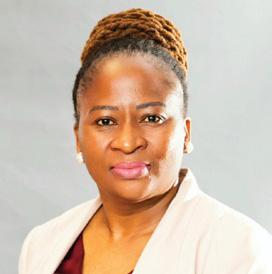


MMzwanele Lingani, a Senior Agricultural Economist of the Western Cape Department of Agriculture (WCDoA), completed his second Master’s qualification; the first being Master of Agriculture. His second is a Master of Sustainable Agriculture (MSA) qualification Cum Laude with the University of the Free State. The degree was awarded in April 2024. This was made possible through a bursary awarded by
the Department under its human capital development programme.
Human capital is the heartbeat of any organisation that cares about its future, clients and the economy at large to thrive and expand.


The MSA programme that Mzwanele studied under, is designed to prepare graduates to be leaders and specialists in the field of sustainable agriculture. The structured Master’s programme in Sustainable Agriculture is expected to allow students from various fields to analyse and apply the theory and the methods to support sustainable agriculture.
As a Senior Agricultural Economist responsible for farming management and production economics, the qualification has assisted Mzwanele on many fronts, especially effective communication with producers, industry organisations, commercial banks and other Provincial Departments while at the same time providing technical economic advice to all ranges of producers regardless of the commodity. Since the programme offers modules in economics, livestock production, extension and advanced soil and climate assessment, it is easy to blend all the knowledge gained to provide assistance that is relevant to producers irrespective of the size of their operation.
As a requirement of the MSA programme, research on issues relating to estate and succession planning was conducted under supervision of Dr Ella C Hough.
Estate planning is often avoided by many producers probably because it normally deals with emotions and difficult issues. However, it is one of the most important management processes in any business. Literature has also shown that decision-making on future ownership of many businesses is poorly understood.
Many farmers supported by the WCDoA have passed away within a space of five years. Accordingly, the future ownership of these businesses in many respects could not be determined or the transition took much longer than expected. It is for this reason that the research carried out investigated estate and succession planning among the businesses benefitting from the WCDoA’s Financial Record Keeping Programme. To obtain data, farming businesses were interviewed in almost all the district municipalities of the Province. The results of this work will be shared in future articles. AP
For more information, contact Mzwanele Lingani: mzwanele.lingani@westerncape.gov.za
by Dr Lungelo P. Cele


TThe South African olive industry has experienced substantial growth over the past few decades, positioning itself as a noteworthy player in the global olive oil
market despite relatively low production volumes compared to other major Mediterranean regions in Spain and Morocco.

Data source: ITC Trade Map, 2024
The South African olive oil industry has seen remarkable growth. From 2013 to 2023, olive oil exports surged by 131%, from R37 million to R86 million (see Figure 1). Namibia, Botswana and Zambia are the primary markets for South African olive oil, with impressive growth rates of 137%, 216%
and 404%, respectively. The United States has emerged as a significant market, with a 549% growth rate, from R903 000 in 2013 to R5 million in 2023. These statistics underscore the expanding footprint of South African olive oil in both regional and international markets.
2: Trends in olive oil (HS1509) imports by SA.
Data source: ITC Trade Map, 2024
South Africa is the second-largest importer of olive oil in Africa, following Morocco. The country’s import market has grown by 84% to R291 million in 2023, highlighting the increasing domestic demand and the potential for local production to meet this demand. Imports from Spain, the dominant supplier, have grown by 251%, from R57 million in 2013 to R200 million in 2023 (see Figure 2).
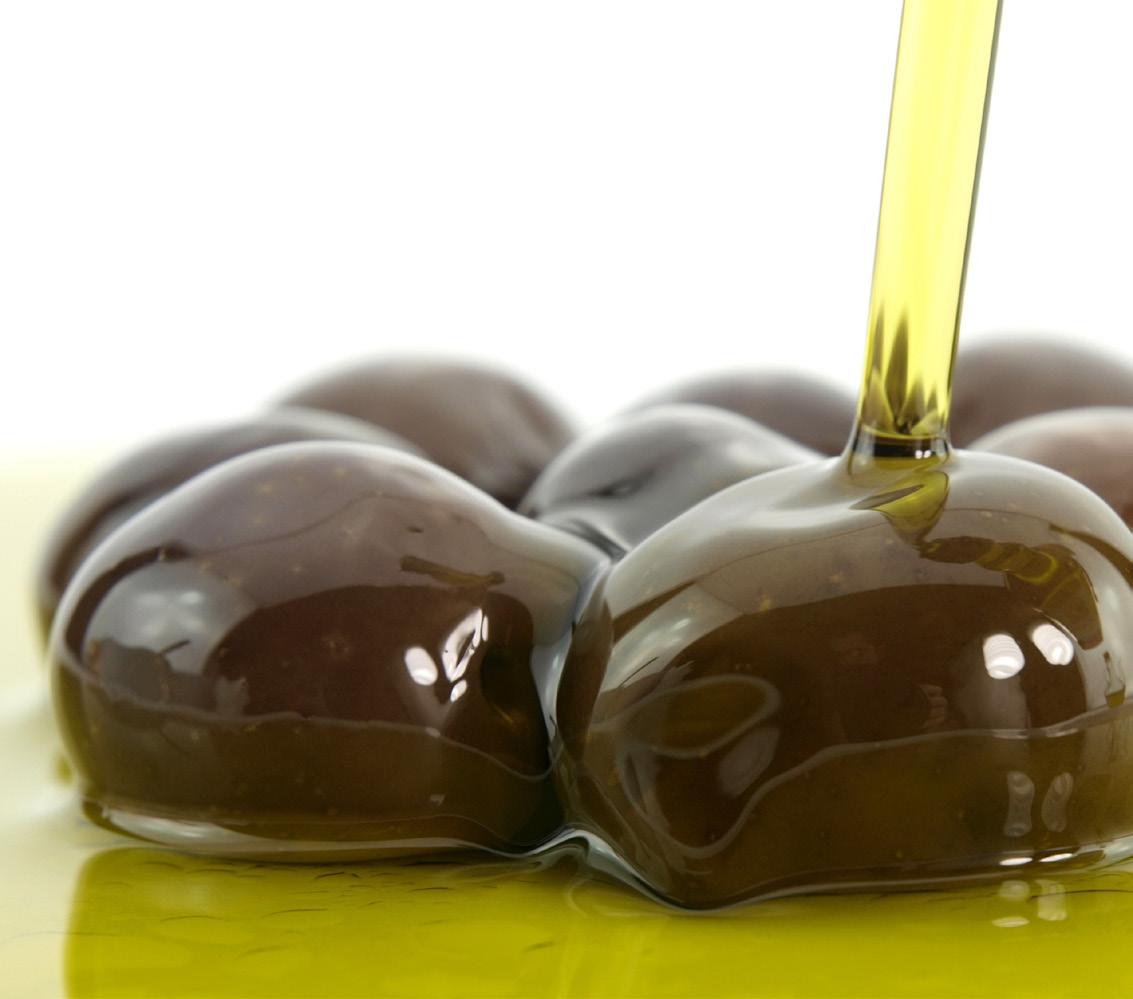
Data source: ITC Trade Map, 2024
Pricing insights
Import prices from Türkiye and Spain are the lowest, with Türkiye showing the highest growth rate of 208%, reaching R43 000 per ton (see Figure 3). Export prices within the Southern African Development Community (SADC) are highest in Botswana at R67 000 per ton and lowest in Zimbabwe at R49 000 per ton. These pricing insights are crucial for strategic planning and competitive positioning.
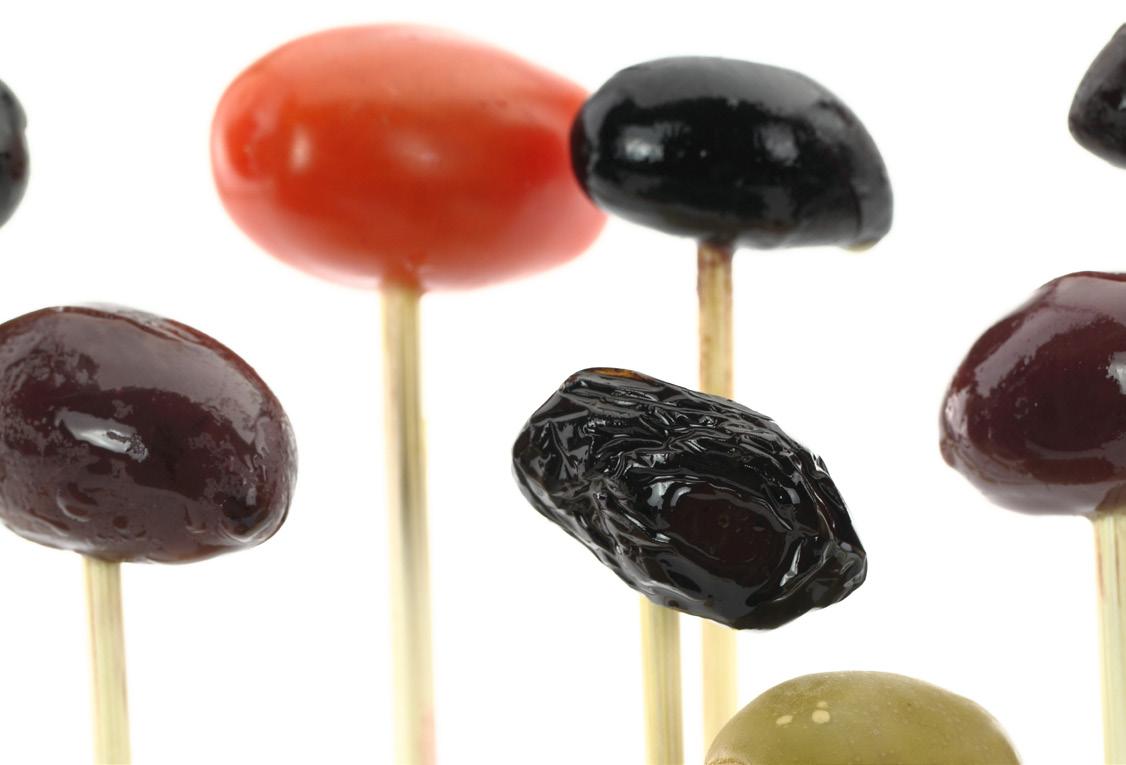
Global position and quality recognition
Globally, South Africa is ranked 28th for olive oil exports and third within Africa. For extra virgin olive oil (EVOO), South Africa is the second-largest exporter in Africa and 21st in the world, with exports valued at R49 million in 2022. This highlights South Africa’s reputation for producing highquality olive oil, recognised in international competitions. South Africa won multiple awards over the years with 15 awards and a success rate of 100% in 2023, highlighting the quality and competitiveness of local products globally (see Figure 4).
Opportunities and challenges
Aligned with the Department of Trade and Industry (DTI)’s sector development plan in 2013, the South African olive oil industry has immense growth opportunities. However, the industry faces several challenges, namely:
World oversupply: The global market is dominated by EU countries, leading to oversupply and competitive pricing pressures.
High imports: The significant import market in South Africa impacts both domestic prices and export competitiveness.
Regional competition: Countries like Portugal, specialising in EVOO, export to key markets in the SADC region, increasing competition.
Protectionism: Trade agreements and subsidies in the EU can affect market dynamics and competitiveness for South African producers.
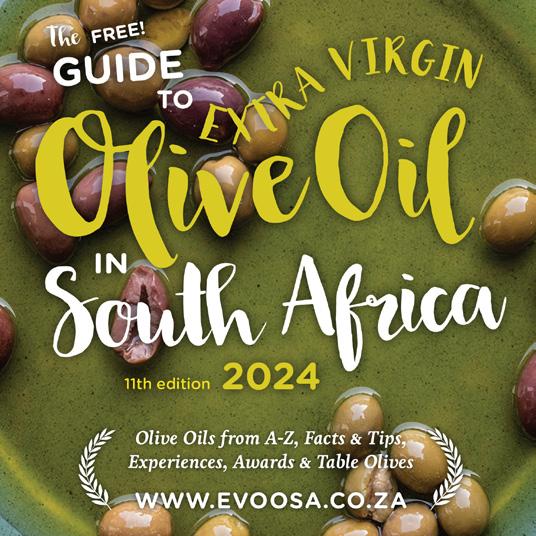
Scan the QR code or visit shorturl.at/rlmzr to download the Guide to Extra Virgin Olive Oil in South Africa, 11th edition, 2024.
“Strategic planning, research and leveraging international recognition are crucial for the sector’s continued success.”
To address these challenges and harness opportunities, several strategic actions are recommended:
Diversification: Expanding into markets outside SADC, leveraging trade agreements like the African Continental Free Trade Area (AfCFTA), and the African Growth and Opportunity Act (AGOA).
Market research: Understanding consumption patterns, price sensitivity, and the impact of vegetable oils on olive oil demand can provide valuable insights for strategic planning.
Food fraud prevention: Implementing food fraud vulnerability assessments to protect the industry’s reputation and ensure product authenticity.
Geographical indications and branding: Investigating the potential for establishing geographical indicators for Western Cape olive oil products to enhance market differentiation and price premiums. Additionally, encouraging the establishment of olive oil brands can drive transformation and inclusiveness. This can also help to boost olive oil tourism.
The South African olive oil industry, despite facing global competition and market challenges, has demonstrated resilience and growth. Strategic planning, research and leveraging international recognition are crucial for the industry’s
continued success. With the right support and initiatives, South Africa can solidify its position as a leading exporter of highquality olive oil, contributing to economic growth and job creation.
For more detailed insights and strategic recommendations, stakeholders are encouraged to explore the full report and engage in discussions on opportunities within this vibrant sector. AP
Scan the QR code or visit shorturl.at/DV8U8 to download the full report.
Learn more!
Scan the QR code or visit
1. evoosa.co.za/producers
2. saolive.co.za

For more information, contact Dr Lungelo P. Cele: lungelo.cele@westerncape.gov.za
by Shelton Mandondo


On 24 May 20241, the Western Cape Department of Agriculture (WCDoA), in partnership with Wesgro, Nedbank and Mazars Cape Town (a leading international audit, tax and advisory firm) commemorated Africa Day by convening an annual business seminar at the Nedbank Clocktower Building in the V&A Waterfront.
AAfrica Day is celebrated on 25 May each year to commemorate the founding of the Organisation of African Unity (OAU), which was established on that day in 1963 and later became the African Union (AU).
1 In 2024, the 25th of May occurred on a Saturday and the Organising Committee took a resolution to celebrate it on the Friday, a day before the actual date.
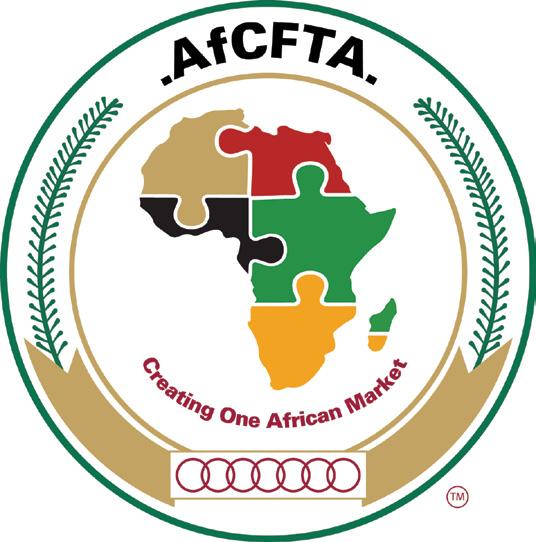
The 2024 chapter was a day to reflect on Africa’s journey, celebrate its achievements, and reaffirm the commitment to address the continent’s challenges and the ongoing endeavours to foster political and socio-economic integration across the continent.
Approximately 120 delegates comprising business captains, government representatives and consular generals from different countries gathered to discuss the thematic area “Bridging Borders: Trade, Finance, and Free Movement as Catalyst for the AfCFTA”2 In as much as government representatives are making a concerted effort to showcase their countries’ unique selling points with respect to business offerings and the enabling socioeconomic conditions, the majority of the business delegates shared mixed feelings regarding AfCFTA and the readiness of African countries to ratify and implement the agreement.

AfCFTA Agenda 2063: The Africa We Want
It is the world’s largest free trade area bringing together the 55 countries of the African Union (AU) and eight Regional Economic Communities (RECs) to create a single market for the continent. The aim is to enable the free flow of goods and services across the continent and boost the trading position of Africa in the global market.
Learn more!
Scan the QR codes or visit:
1. au.int/en/documents
2. tinyurl.com/y966k3bd
Watch this!
Scan the QR code or visit shorturl.at/PCyV4
2 The African Continental Free Trade Area (AfCFTA) is one of the flagship projects of the African Union (AU).

The diagram below presents a truncated state of Africa from the delegates’ perspective.
• 1.5 billion people live in Africa, making it the fastest growing population in the world. This offers a great opportunity for agricultural expansion as each person is linked to food or clothing product.
• Globally Africa has the second fastest growing economy after Asia.
• Onshore and offshore security have improved.
• Many investors want to come back to Africa
• Positive democratic change in key economies – Nigeria, Kenya and South Africa on 29 May.

• Decolonising the African mindset is imperative. A prospective investor from Africa needs 35 visas to travel within Africa, yet European tourists travel visa-free around the continent.
• Very few (28%) African countries allow visa-free entry.
• Allegations of Afrophobia in some countries.
• Exorbitant visa fees charged in USD. Governments use visas as revenue raising programmes.
• Delays in issuing visas – no defined processing times.
• A lack of infrastructure: poor transportation links, delays at border posts, low-quality road infrastructure, a lack of port equipment, low electricity levels, and inadequate financial infrastructure all make African products less competitive because it is comparatively more expensive to move, finance or produce products in Africa.
Did you know?
The map pays homage to the mighty African continent and boasts a circumference of 30 metres.
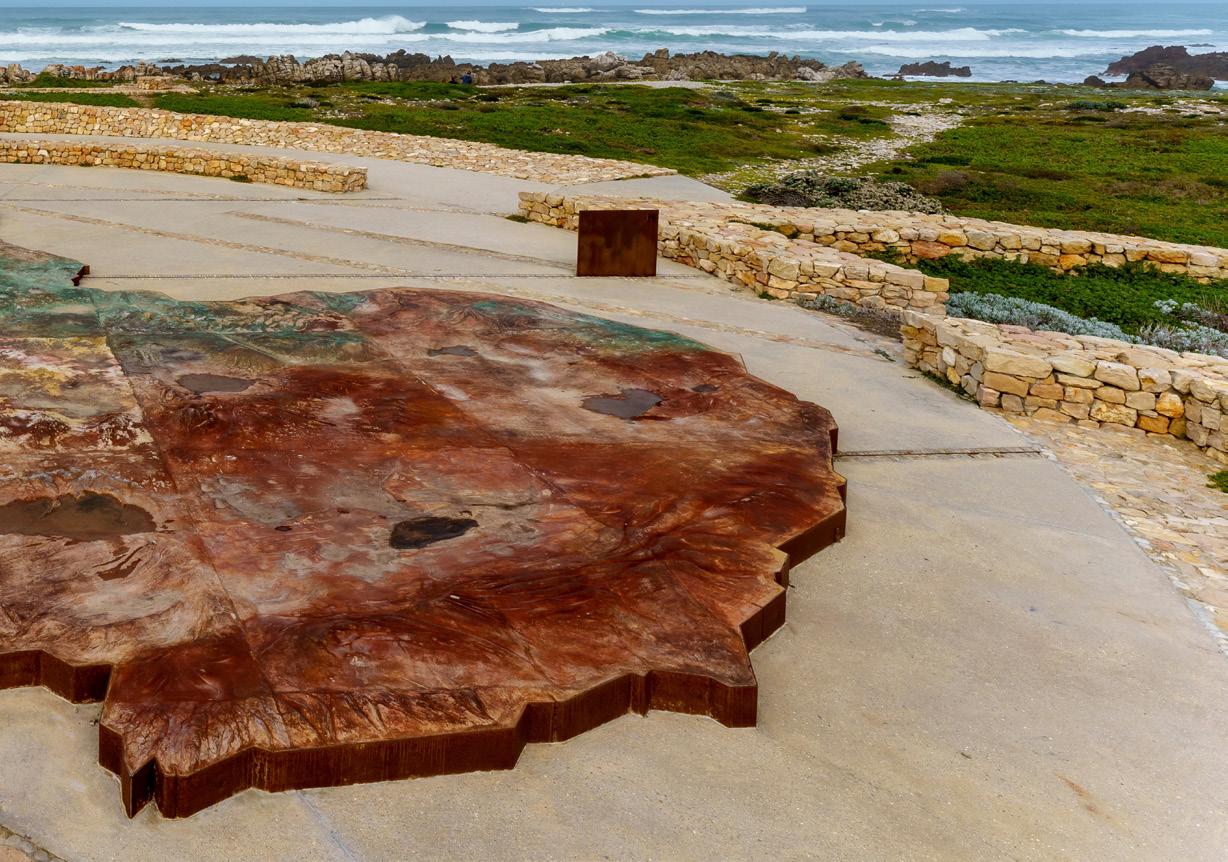
The challenges that many African countries face in establishing the necessary frameworks for the free movement of people are indeed complex. Factors such as infrastructure, policy harmonisation, security concerns and economic disparities are a real impediment towards the continental integration. Having said this, it was encouraging to witness the commitment of delegates to advance the free movement agenda. This can be achieved by:
Incremental implementation. Starting with regional blocks that have similar policies and gradually expanding.
Investment in infrastructure. Improving transportation and border facilities to ease movement.
Policy alignment. Harmonising laws and regulations to reduce barriers. Capacity building. Training officials and investing in systems to manage the movement efficiently.
Progress in these areas, even if gradual, can help build the momentum needed to realise the vision of free movement across the continent. It’s a goal that holds the promise of enhanced economic growth (commerce and tourism), labour mobility, cultural exchange and regional integration. AP
For more information, contact Shelton Mandondo: shelton.mandondo@westerncape.gov.za
by Tshepo Morokong


TThe 2023 Western Cape (WC) Agricultural Sector Profile presents the sector’s performance and highlights key trends, shaping it within the context of the prevailing policy environment using the 2022 statistics. The one-year data lag in the reporting of the sector’s performance is due to the use of multiple databases that are updated at different times. Hence, whilst some of the data is updated annually, other data sources are updated less frequently and will remain the same.
The WC Agricultural Sector Profile discusses key topics starting with an
overview of the province, followed by agricultural production trends, agricultural land-use change, subsistence farming, investment, infrastructure, domestic markets, agro-tourism and water use.
A special chapter for 2023 focuses on the impact of loadshedding on the sector. The report can be accessed at this link: tinyurl.com/msxnuayd
Agriculture is one of the key strategic sectors in the WC. In the past 10 years, the WC’s agricultural Gross Value Added (GVA) increased by an annual average growth rate of 3.6%. In 2022, the WC recorded 216 000 primary agriculture jobs, increasing the agricultural sector’s share in total WC employment from 8% at the end of 2021 to 8.1% in 2022.
Loadshedding adversely affected the WC agricultural sector’s operations. The impact of power outages was more severe in irrigation farming regions. Electricity demand for agricultural irrigation increases during the hottest and growing months. Coupled with the increasing cost of fuel (e.g. petrol and diesel) on business operations, the production costs were elevated.
The largest relative investment increase in 2022 was 36% in information and communication in agriculture. This was followed by machinery and other equipment, which increased by 5%.
In 2022, about 614 agricultural land transactions through markets were recorded in WC. More than half of them were concentrated in the Garden Route (Eden). Whilst the amount of agricultural land supplied in the market has dwindled in the past three years, the asking prices have significantly increased due to the growing demand.
The number of households participating in non-commercial agricultural activities declined by 35% from 84 567 in 2011 to 54 644 in 2022. However, from 2021 to 2022 there was an increase of 17% in the number of households participating in noncommercial agriculture. More than half of the households participating in agriculture were involved in crop, livestock and poultry production. The majority of households produce for their own consumption, and

others sell some of their surplus produce at both formal and informal markets.
Overall, the WC agricultural sector continues to persist and maintain its socioeconomic value despite major disruptions in the micro and macro-economic environment.
As a strategic sector that contributes to food security, employment and economic growth, its success has positive spillover effects on the rest of the domestic economy.
The next Western Cape Agricultural Sector Profile 2024 publication is expected in February 2025. It will include an update on the 2023 agricultural land-use change based on the third iteration of the flyover in WC, among other key statistics. AP
For more information, contact Tshepo Morokong: Tshepo.Morokong@weterncape.gov.za
by Dr Dirk Troskie


TThe result of the national and provincial elections of 29 May 2024 is that one political party won an outright majority in the Western Cape Province and thus received the voter-mandate to form the government of the Province. Although it is the same political party as previous, it is a new government.


“A strategic plan is a journey, not an event.”
In accordance with the framework of the Department of Planning, Monitoring and Evaluation (DPME) in the Presidency, each national and provincial department has one year to develop a Strategic Plan (SP) for the period 2025/26 – 2030/31 and an Annual Performance Plan (APP) for 2025/26. The latter must cover the targets for the first of the five-year SP period. The Western Cape Department of Agriculture (WCDoA) expects that both documents will have to be tabled during March 2025 in the Provincial Legislature.
Constitutionally, agriculture is a “concurrent” legislative function between
national and provincial spheres of government. Furthermore, all agricultural activities leave a footprint in one or more local government areas and agriculture is also the most competitive sector of the economies of all five districts of the Province. Consequently, the strategies and priorities of all three spheres of government must be taken into account by the WCDoA during SP development. Furthermore, the feasibility of agricultural interventions is limited by the boundaries of the possible (i.e. what our natural resource base, human characteristics and economic structure allow) while external risks and trends can overturn plans.


The WCDoA believes that SP development is not an event with flipcharts and breakaway sessions, but a process stretching over a year. Hence, the SP and APP development will take place in the following three phases:
1 Diagnostic. As the WCDoA is a continuous learning Department, it has completed 40 external evaluations over the past decade (all evaluation reports are available on the Departmental website). These evaluations include:
a. A diagnostic and design evaluation of the services needs of various farmer categories.
b. The third iteration (conducted every five years) of the effectiveness of the WCDoA’s support to land reform beneficiaries.
One of the recommendations of an external evaluation of the effectiveness of its COVID-19 response, was that the WCDoA should implement a more responsive sense-making process towards external calamities. For this reason, the
“The Department’s clients and staff are actively involved in the strategic planning process.”
Department has commissioned the Bureau of Food and Agricultural Policy (BFAP) to conduct a quarterly external risk analysis.
In addition, the Department has been conducting a production census (the socalled “flyover” project) every five years and the most recent iteration was released in March 2024. In order to complement the information provided by these sources, electronic questionnaires were circulated to the staff of the Department, industry organisations and other stakeholders. The results from these surveys were validated through focus group discussions.
The information from all these sources is used to compile a Strengths, Weaknesses, Opportunities and Threats (SWOT) analysis of the Department.

2 Joint learning. As agriculture is a concurrent function, the provinces of South Africa effectively imply nine “laboratories” for agricultural strategy and implementation. The “Joint Learning Project” was a mechanism to unlock the lessons learned and to this end approval was obtained from MinTech to record and share successes. A process to document key interventions was instituted and shared during a workshop on 13 June, and on 14 June the African Network of Agricultural Policy Research Institutes (ANAPRI) was invited to share success stories from the rest of Africa.
. During the Departmental Strategic Session (20–23 August 2024) the first two phases have been concluded, and the final phase has begun. A TOC is a causality argument (cause and effect) or the domino effect (given scarce resources, which domino needs to be flipped so that the whole line of dominoes tip?). During the Strategic Session the validity of the Department’s systems approach and existing TOCs will
Cape Farm Mapper showing the provincial boundaries and the main crops of the Western Cape.
The Western Cape (WC) region is the most southerly and the largest of the nine provinces of South Africa. It sweeps along the western and southern edge of the country, with coasts along the Atlantic Ocean (west) and the Indian Ocean (east). In 2022, the WC recorded 216 000 primary agriculture jobs, increasing the agricultural sector’s share in total WC employment from 8% at the end of 2021 to 8.1% in 2022 – read more on page 36.
be evaluated and amended if necessary. During the same event the need for new TOCs will also be determined and these, together with existing TOCs needing in-depth analysis, will be prioritised. The four to six with the highest priority will be developed during separate workshops during September and October and the remainder will be included in the Department’s evaluation programme in subsequent years.
In this way the first draft of the SP and APP will be ready by mid-October and the final version will be tabled in March 2025. AP
For more information, contact Dr Dirk Troskie: dirk.troskie@westerncape.gov.za
We know that the Western Cape is in many ways a unique province, but did you know…
by Riaan Nowers


TThat the Western Cape has and play host to:
306 4x4 routes on farms with a projected distance of 9 261km
2 117 agri-tourism farm stays
57 agri-routes
977 wine cellars
269 ecotourism ventures
146 farm markets
238 farm stalls
550 festivals
129 hiking trails on farms
201 farms with mountain bike trails
538 on-farm restaurants
43 agricultural shows
At least 119 sporting events in rural areas, with road running, trail running and mountain biking events the most popular
134 tourism bureaus
314 on-farm wedding venues
Average agricultural land prices of R21 354 per hectare with land in the Cape Metropole averaging R221 775 and Central Karoo R2 542 per hectare
Biltong hunting prices increase by 37.1% with trophy hunting prices at 38.1% higher than last year.
Scan the QR code or visit shorturl.at/pf1Sh for more statistics.
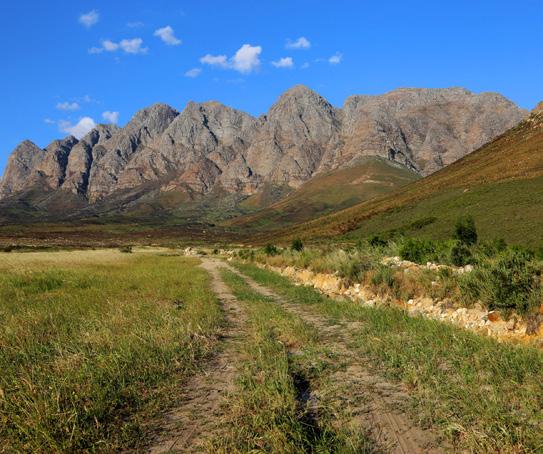
BOSJES Estate and the Breedekloof Valley offer diverse and exciting activities.
Learn more!
Scan the QR code or visit bosjes.co.za
Photo © Adam Letch
Two hiking trails of 5km and 12km have been opened in the renosterveld of the Waaihoek Mountains – the more active may be treated to a sighting of eland, springbok, bontebok, wildebeest and ostrich.

The BOSJES Boombrug canopy walk and a vertical labyrinth reward both the meditating wanderer and adventurous young hikers.
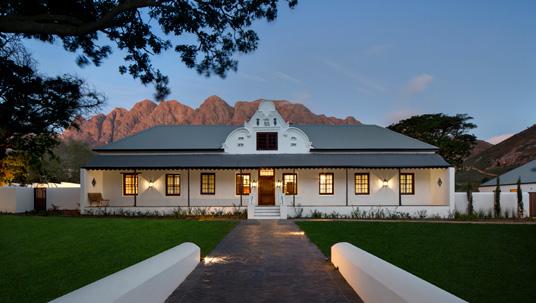

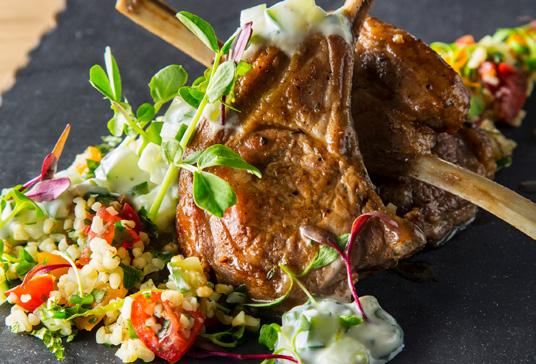


Watch this!
Scan the QR code or visit shorturl.at/eN90A to watch the video: ‘Architectural Masterpiece – Bosjes Chapel’. Published by Expresso Show AP



RRSG Landbou is waarlik enig is sy soort. Nêrens anders in die wêreld maak ’n landbou-departement sy eie program moontlik wat op ’n nasionale stasie uitgesaai word nie. Dis een van die vele innovasies by die Wes-Kaapse Departement van Landbou.
Die geliefde dr. Chris Viljoen het destyds die land deurkruis om boere-vertellings te versamel. Die taak het hy behartig tot op ouderdom 74 voor hy die tuig neergelê het. Eertydse tegnologie is ingespan, byvoorbeeld die gebruik van die Nagrabandopnemer. Dit was ’n bonkige kalant met roterende bande, inprop-mikrofone en derduisende drade wat rondkarwy is om sodoende van die mees onvergeetlike landbou-insetsels en -staaltjies te verewig.
“RSG Landbou is my lewensverklaring.
Wat jy (uit)saai, sal jy maai.”

Het jy geweet? – die Nagra-model in die beginjare van RSG Landbou was dieselfde as wat die Beatles in 1965 gebruik het om hul Love Me Dodebuut vas te lê. ’n Era waarna ek met dankbaarheid knik. Een wat deel daarin sou hê om my eie pad te plavei.
Leer meer!
Skandeer die QR-kode of besoek shorturl.at/w1Xa4
“Jou vrae is kort, gefokus en karteer die menslikheid van die deelnemers.”
Veranderende tye beteken hersiene metodes van draagbare digitalisering en rugsaktegnologie. Vandag is dit moontlik om ’n bewegende radiostasie te wees. Met behulp van mikrotoestelle vir opneem, selfone, flukse redigeringsprogramme en ’n skootrekenaar kan ek op enige plek op aarde ’n program saamstel en dit stuur na waar ook al. In dié geval, Radio Park – die setel van die SAUK in Auckland Park – vir uitsending op RSG.
“Dankie dat jy die program verteenwoordigend hou en die jong en bruin boere hierdie wonderlike spreekgeleentheid bied. Jou program is keurig geredigeer. Wat ’n absolute plesier om te luister!”
Hoewel die lewe toenemend ’n episode van die destydse TV-program Beyond 2000 naboots, en soms soos ’n Terminator-film voel (veral met snelle ontwikkeling van robotika en kunsmatige intelligensie), bly die rol van landbou en om die aarde te bewerk dieselfde sedert die bestaan van die mens of die oerknal of wat ook al jy glo – ek en jy is in ons diepste wese van landbou afhanklik vir oorlewing.
“Hallo, wat ’n ongelooflike onderhoud wat Eloise vir ons gebring het. Dit laat ’n mens net weer besef hoe ons navorsers werk! Hoop om nog baie sulke stories te hoor op die program, baie dankie Eloise!” Louise van der Merwe, Bloemfontein
“Wat ’n pragtige opvoedkundige program. Nog baie asb., Boeremeisie.”
Dis weliswaar ’n liefdesdaad om jou nou agter die gordyn van RSG Landbou te neem. Voor die rooi record-lig aangeskakel word, is daar leeswerk betrokke. Baie daarvan. In die vroeë oggendure. Wyd en syd. Instink. Intuïsie. My self opgelegde beweegrede: RSG Landbou moet gefundeer staan op hoop en inspirasie. Ook vermaaklik wees, vir diegene binne en buite ons sektor. Dit is immers ’n radioprogram. »

Kom ek laat jou in op my dagtake. Die uitnodiging word aan individue gerig. Gaste ontmoet my meesal by die Departement van Landbou se byderwetse ateljee. ’n Plek waar daar oor jare trane van vreugde, verlies en vernuwing gestort is. Male sonder tal is die uitsaaityd gegun, ná redigering, nie voldoende om die gaste se passie en vertellings na behore te dek nie. Die uitdaging verskuif dan na my redigeringsmes. Een wat ’n ouditiewe ervaring van gehalte moet meebring. Daar’s hope genade wat bevestig word deur my mengbank, met die skrille skiet van die kontroles se meternaalde. RSG Landbou het haar gevestig as veel
meer as ’n landbou-program. As een van die gewildste leefstylprogramme op die grootste Afrikaanse radiodiens wat bestaan, staan mense telkens nader om egte goed, alledaagse dinge, gade te slaan. Ja, ek glo in radio wat jy kan sien. Hoorbeelde oor voornemende boere, en hoe hul leer leef. Dierefeite wat mense wil verstaan. Hulle daaraan vergaap. Gesprekke oor grondsake wil Suid-Afrikaners gegun word. In die moderne eter-era wend kunstenaars, soos ek, hul graag tot betroubare wetenskap, wat luistertalle louter. En lewer. Dankie tog daarvoor. Die Ponte Vecchio moes sekerlik ’n pad na bewysbare werk in toekomshand gehad het...

“Dit is fassinerend! Sjoe!!” Erna van Welkom X
RSG Landbou is my lewensverklaring. Wat jy (uit)saai, sal jy maai. Verken die grond saam. Skakel in. Verbreed jou horisonne. Wie jy ook al is, en waar jy jou ook al in die mooie land van ons bevind. Die uitnodiging aan jou gerig is nie gebonde aan tyd nie. Radio, soos landbou, gaan jou oorleef. En, wanneer die bewaarders en bewerkers van die aarde deel van jou DNS word, soos by my, is die landbou-narratief die kosbare een wat jy in hemelsnaam in jou koker plaas en

saamdra, om medemenslikheidshalwe, as deelnemer van die lewe.
Die Wes-Kaapse Departement van Landbou se RSG Landbouprogram word Vrydae 5:25 en Saterdae 11:45 uitgesaai. Hou elke program as digitale aandenking deur dit af te laai vanaf elsenburg.com
Meer inligting oor die programreeks is beskikbaar op www.rsg.co.za en die uitsendings kan ook afgelaai word. Vir aflaai van potgooie, skandeer die kode of besoek www.rsg.co.za/rsg/page_id344/ Nou ook beskikbaar op die RSG-toep! AP
Vir meer inligting, kontak Eloise Pretorius: eloise.pretorius@westerncape.gov.za
deur Dr Shaun Sagor

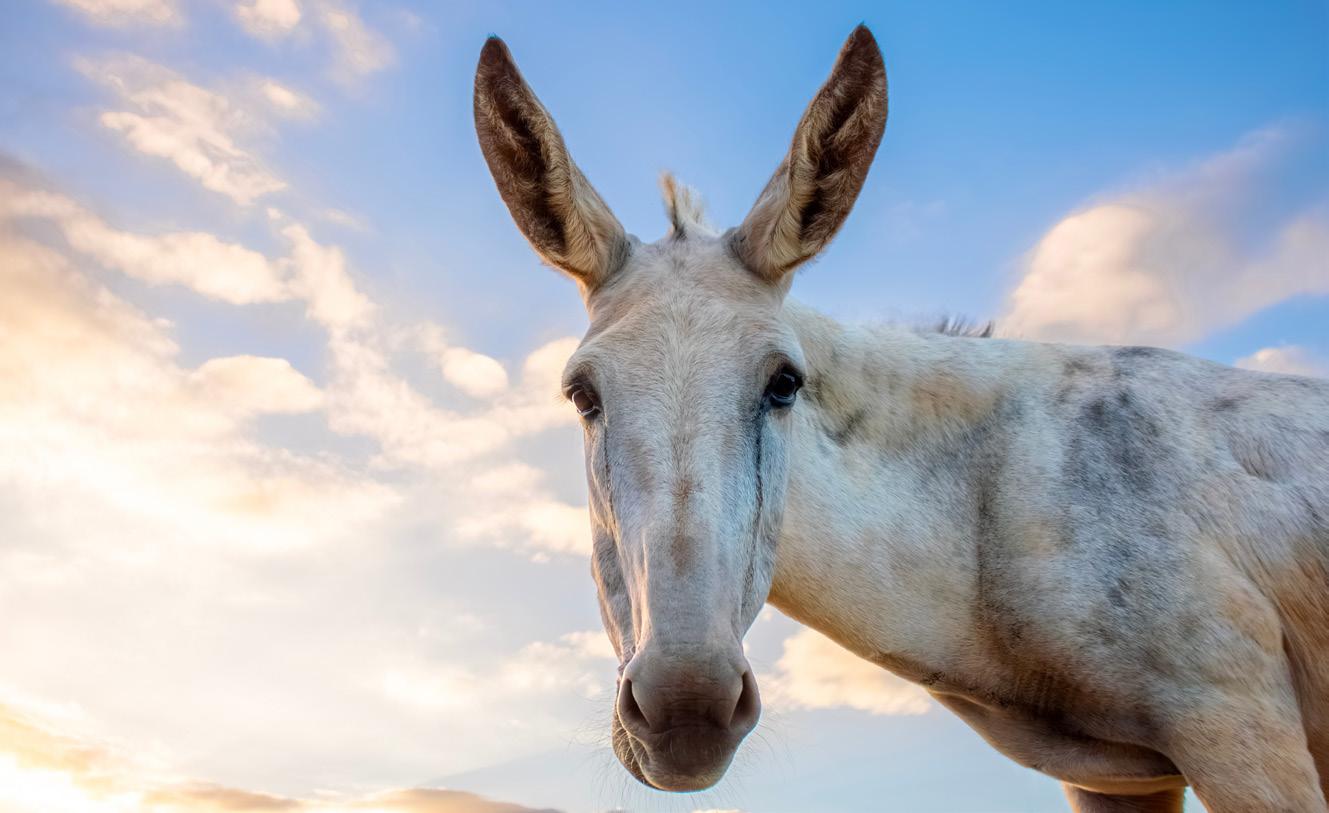
The donkey or ass is a domesticated equine. It derives from the African wild ass, Equus africanus, and may be classified either as a subspecies thereof, Equus africanus asinus, or as a separate species, Equus asinus It was domesticated in Africa some 5 000–7 000 years ago, and has been used mainly as a working animal since that time.
TThe State Veterinary (SV) office in Oudtshoorn hosted and jointly organised a OneHealth, One Welfare Animal workshop focusing on donkeys. The workshop was presented by the Eseltjiesrus Donkey Sanctuary in McGregor. A workshop that wasn’t just about harnesses and hooves, but rather delved deep into the holistic well-being of donkeys. “There are over 44 million donkeys worldwide and sadly so many are subjected to neglect and
abuse, overworked and left in agony to die. This happens due to a lack of education, a lack of understanding of what good care looks like and the hardships of day-to-day life facing families and communities across the world,” said the Donkey Sanctuary UK. The workshop shone a spotlight on these oftenunderappreciated creatures, emphasising their care, welfare and importance in various aspects of human life.

Hosted by the passionate Eseltjiesrus Donkey Sanctuary who are experts in donkey welfare, the workshop brought together Animal Health technicians, State Veterinarians and animal welfare enthusiasts from Oudtshoorn, Beaufort West, George, Calitzdorp and Mossel Bay.
The overarching goal was clear: to foster a deeper understanding of donkey behaviour and needs, and appropriate management practices, with an emphasis on a holistic approach to their well-being.
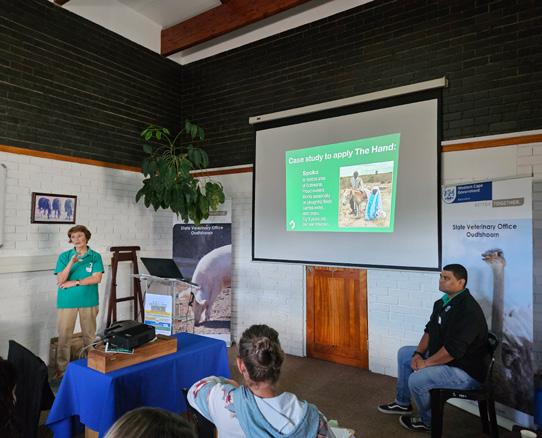
The workshop also provided practical insights into donkey care, covering topics such as nutrition, housing and healthcare. Participants learned about the nutritional requirements of donkeys, emphasising the importance of providing a balanced diet tailored to their specific needs. Additionally, discussions revolved around the design of suitable living environments that promote donkey health and natural behaviour.
One of the central themes of the workshop was the acknowledgment of donkeys as sentient beings with complex emotional and social needs. Participants were enlightened about the intricacies of donkey behaviour, communication and psychology, which are often overlooked in traditional management practices. »
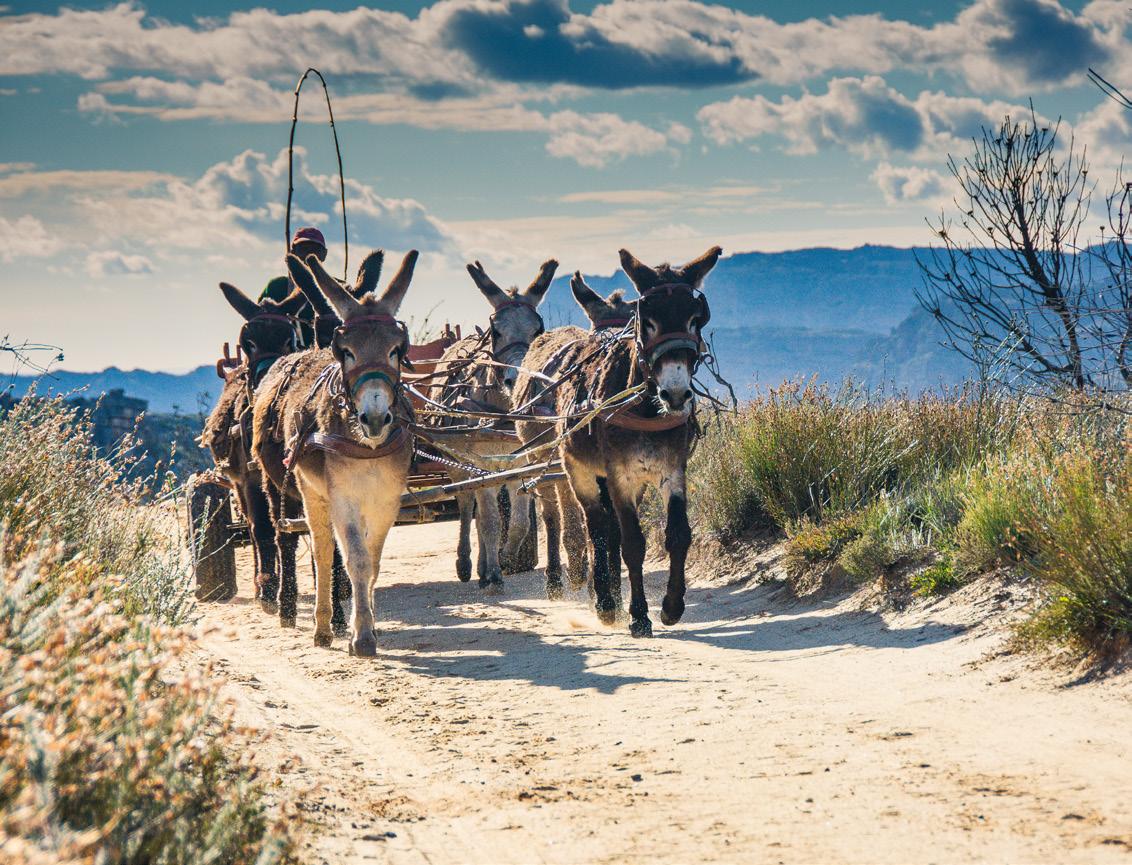
The Cederberg Wilderness Area is a CapeNature region where you can get up close and personal with donkeys. Donkey carts are the traditional way to travel in the Cederberg – locals used to use donkeys to carry their produce to Clanwilliam.
Scan the QR code or visit shorturl.at/lSMmX
Beyond the practical aspects, the workshop sparked conversations about the ethical and cultural significance of donkeys. From their historical roles in agriculture and transportation to their symbolism in various cultures, donkeys hold a special place in human society. So much so that a saying exists in Ethiopia, “If you don’t have a donkey, then you are a donkey.”

Recognising and honouring this connection is vital for promoting their welfare and safeguarding their future.

Towards the end of the workshop, all participants took part in a practical session with local donkeys from a smallholding in Oudtshoorn. The components that were touched on earlier in the day were then practised in a real-world scenario, allowing participants to put this valuable information into action.
This session emphasised the need to move away from the one-size-fits-all approach when it comes to donkey management. Each donkey is an individual with its own preferences and requirements. By taking a holistic approach, we can ensure that their physical, mental and emotional needs are met. AP
isiXhosa summary
i-Ofisi ese Oudtshoorn neyiyeyooGqirha kuNyango Lwemfuyo nguRhulumente, imeme ze yenza amalungiselelo ocweyo ne “OneHealth, One Welfare Animal” nobelugxile kwiimbongolo. Olu cweyo luhlinzekwe liziko logcino-zintaka i”Eseltjiesrus Donkey Sanctuary” elise McGregor. Omnye umxholo obe ngumongo kolu cweyo ibe kukuqatshelwa kweembongolo nje ngezidalwa ezinayo imvakalelo neziqheleka nzima kunye neemfuno ezizezazo kwiindlela eziphila ngayo. Abathathi-nxaxheba baye bafundiswa ngokungagqibeki kwiindlela imbongolo eye iziphathe ngayo, eyenza ngayo unxibelelwano kunye nokusebenzisa ingqondo, nekuvamise ukuba kungathathelwa ngqalelo kwiindlela eziqhelekileyo zokusebenza ngazo. Olu cweyo lusekwancede ngokunika ulwazi
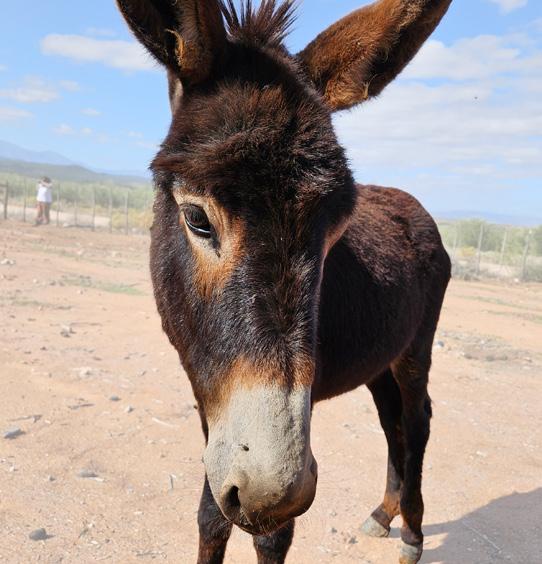
Learn more!
Scan the QR code or visit donkeysanctuary.co.za
Watch this!
Scan the QR code or visit shorturl.at/jVSC9 to watch the video: ‘Donkiehemel’ composed and performed by David Kramer, patron of Eseltjiesrus Donkey Sanctuary.
ngeendlela ezisetyenziswayo ekuzikhathalaleni, ze kwaqukwa nemixholo emalunga nohlobo lokutya ekuzilungelayo, indawo ezihlala kuzo kunye nokuzonga. Ngaphaya kwemicimbi yokusebenza ngazo, olu cweyo luveze iincoko ezingokubaluleka kwiindlela zokuziphatha kwa nenkcubeko yeembongolo. Ngokwembali kwimisebenzi ezisetyenziselwe ukuyenza kwezolimo nothutho neendlela ezizibonakalisa ngazo kwiinkcubeko ezahlukeneyo, iimbongolo zinendawo ekhethekileyo ekuphileni koluntu. Yilento kwilizwe lase Topiya kude kwakho nentetho ethi “ukuba awunayo imbongolo, loo nto ithetha ukuba nguwe lo uyimbongolo.” Ngelokuxhasa imisebenzi engentlalo-ntle kunye nokukhusela ikamva lazo, kuyinto ebalulekileyo ukubona kunye nokuhlonipha olu nxibelelwano.
For more information, contact Dr Shaun Sagor: shaun.sagor@westerncape.gov.za
by Daniel Johnson

DDr Ivan Meyer, Western Cape Minister of Agriculture, opened the newly renovated and upgraded Provincial Veterinary Laboratory (PVL) in Stellenbosch in May 2024.
“This is a moment for celebration by the Western Cape veterinary community as it ushers in an enhanced level of services to the agricultural sector by this government”, said Minister Meyer, adding that the PVL, which celebrates its 51st anniversary this year, “is poised to continue its vital role in safeguarding animal health and public welfare. This

Celebratory cake.
milestone is a celebration of longevity and commitment to excellence in animal health, diagnostics, biosecurity and market access.”

“The decision to invest approximately R25 million in the ageing PVL facility underscores the Western Cape Government’s dedication to modernising essential infrastructure for improved service delivery,” said Minister Meyer.
Through strategic investments and upgrades, the PVL is positioned to meet the evolving needs of the agricultural sector and ensure the highest standards of veterinary services. Minister Meyer, emphasising the PVL’s significant role in biosecurity and its nationwide reach, said, “The laboratory serves clients across South Africa, with at least 55% of annual tests conducted for clients outside the Western Cape.”
One such client is Dr Riaan Putter, who owns the George Herd Health Veterinary Consulting Practice in the Garden Route District.
Dr Putter: “We have always received good service from the Western Cape’s PVL. No other state laboratory in
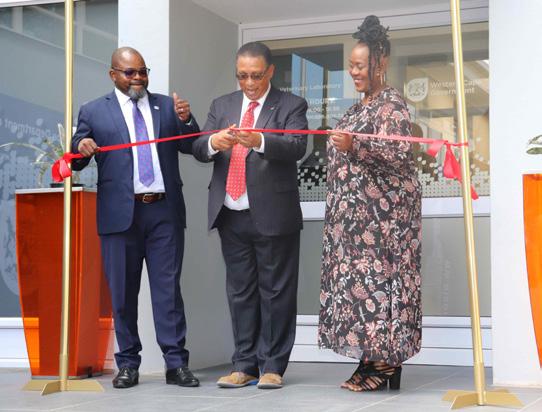
South Africa has the capacity, facilities, manpower and budget to deliver the service we require. The collaboration between the state and private veterinarians is critical for national food security, food safety and for protecting the livelihoods of those who are employed within the livestock industry.”
Minister Meyer added: “Despite seasonal demand fluctuations, the PVL performs an impressive average of 26 000 tests per month across seven main disciplines.”

Dr Ilse Trautmann, Deputy Director General: Agricultural Research and Regulatory Services, says the department’s ISO 17025 accredited PVL laboratory boasts the largest scope of accredited tests among government veterinary laboratories in South Africa, adding that “plans are underway to expand our testing capacity in the upcoming financial year”.
“The SANAS accreditation and DALRRD-approved statuses underscores the laboratory’s commitment to quality and compliance,” said Dr Trautmann.
Minister Meyer, expressing his gratitude to clients for their patience during the renovation and reaffirming that the facility is dedicated to serving their needs, concluded by saying: “The re-opening of the PVL builds on our already strong foundation and commitment to strengthen our capacity to respond to the needs of the agriculture sector.” AP
For more information about the services offered by the PVL, visit shorturl.at/pBkf9
For more information, contact Dr Michelle Seutloali: michelle.seutloali@westerncape.gov.za
Dr Donna Wylie
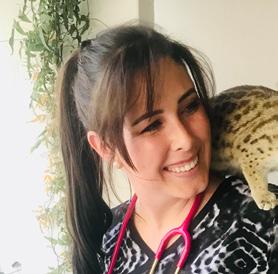

OOrf, otherwise known as “scabby mouth”, “sore mouth” or contagious ecthyma, is a highly contagious virus seen in our sheep and goats worldwide. Not only does this virus spread easily, but it can also survive for many years in the environment in dried up scabs shed by infected animals. This virus has severe economic consequences due to production losses.
The virus typically infects young animals and is spread through direct contact. It causes painful sores, mostly around the mouth, but it can also spread to the rest of the face, ears, hooves and even teats of females.
Animals do not want to eat due to painful mouths and lose weight as a result. Lactating females with sores on their teats abandon their young due to painful suckling. Affected animals can become severely lame if sores develop around the hooves, resulting in reluctance to walk for food or water and therefore they lose condition. Sores that have formed from the virus can become infected with bacteria, worsening the disease in affected animals.
Aside from the severe production losses caused by Orf, why else do we worry and why should we be aware of it?
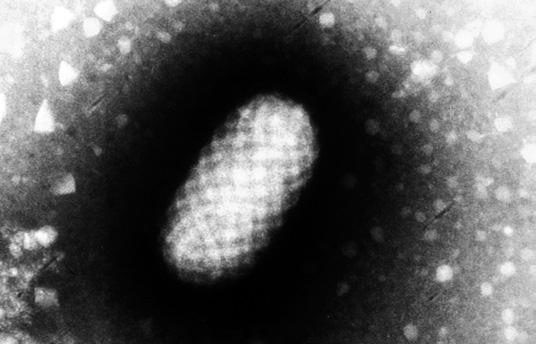
As previously discussed, Orf is found worldwide, it spreads easily, can survive for long periods in the environment and moreover, it is also a zoonotic virus. This means that the virus can spread from infected animals to people! Whilst infection in people is typically mild, it can cause severe health implications in immunocompromised people, like those living with HIV or undergoing treatment for cancer, and even our elderly and young.
Typically, infection only occurs through direct contact with infected animals or equipment that has been used on infected animals. It is highly unlikely that infected people can spread the virus to other people.
This means that those most at risk are individuals working with sheep and goats frequently. Infected people typically develop one or two sores where direct contact occurred, and these sores usually heal on their own within a month or two. Generally, if these sores are kept clean, dry and covered to prevent secondary bacterial infection, individuals heal unremarkably. However, if the sores do not heal and other clinical signs, like fever, develop, medical attention must be sought. It is important to inform the medical professional that the affected individual works closely with sheep and goats.

Now that we know what Orf is and how it is spread, it is important to know how to prevent it and protect ourselves.

People handling animals with suspected Orf must treat all the animals in the group as infected, even if they do not show any signs of Orf, as these animals can still spread the virus. If you suspect Orf in your animals, immediately notify those working with you and take the following precautions: Wear non-porous or latex gloves. Ensure proper handwashing with soap and water after contact. An alcohol-based sanitiser can be used if soap is not available. It is vitally important to disinfect the premises and equipment if you suspect an Orf outbreak as we know that the virus can live in the environment for long periods of time. A Hypochlorite solution readily deactivates the virus, but you must clean the premises first to remove dirt as this stops the Hypochlorite solution working.
The occurrence of Orf in sheep and goats of South Africa is considered to be severely underestimated and as a result, the occurrence in people is likely underdiagnosed. In the United Kingdom, Orf has been reported to be the most commonly

occurring occupational zoonosis, meaning that it is most common animal disease reported to infect people that frequently handle sheep and goats.
Given that South Africa is one of the countries in the world with the highest number of people living with HIV, and the impact on Orf on immuno-compromised people, it is vital that we are aware of this virus in our animals and how to protect ourselves.
Learn more!
1 König, Guido Alberto (2023) Contagious Ecthyma in Sheep and Goats (Orf, Contagious Pustular Dermatitis, Sore Mouth). Merck Veterinary Manual, Profession Version. tinyurl.com/bp5rdyen
2 Scagliarini, A., Piovesana, S., Turrini, F. & Savini, F. (2012) Orf in South Africa: Endemic but Neglected.The Onderstepoort Journal of Veterinary Research 79(1): E1-E8. tinyurl.com/ ye7r27s4
3 Spickler, Anna Rovid (2023) Contagious ecthyma. The Centre for Food Safety and Public Health. tinyurl.com/ mr2yp8es
For more information, contact Dr Donna Wylie: donna.wylie@westerncape.gov.za
by Sibusisiwe Maseko


IIn light of consistent loadshedding and rising electricity costs, the Western Cape Department of Agriculture (WCDoA) sought to support agricultural producers in the Western Cape in understanding the options available to them to become more energy resilient. In partnership with GreenCape, the WCDoA conducted a series of in-person workshops across the districts of the Western Cape.
The objective of the workshops was to drive greater awareness with respect to energy efficiency and provide an overview of the basics of renewable energy in the agriculture sector. Learn more here: greencape.co.za

The workshops were aimed at all producers, including processors and packers, and included information on:
The impact of loadshedding on the Western Cape agricultural sector.
Energy use on farms.
First steps: Where to start when considering alternative energy supply. Solar PV.
Backup storage.
Energy finance options. Case studies.
The workshops were well attended, with over 100 participants attending and engaging interactively with the presenters and the other participants. The workshops highlighted the resilience of the agricultural industry and how players along the value chain are becoming innovative in responding to external pressures, especially with regard to energy. Insights from the workshops were extracted to produce an
Energy Needs Assessment for Farmers document, which offers a step-by-step guide to choosing an energy solution that makes most sense for producers. The document is available for download here: tinyurl.com/5sdjx6cx
Stakeholders can access video links to the recorded virtual workshop by scanning the QR codes or visiting the links:
• Part One - energy resilience for agricultural producers tinyurl.com/2kpcmp27
• Part Two - making the investment tinyurl.com/4k7y4u4x
Although loadshedding has abated in recent months, producers can still use this document to investigate alternative energy options that can assist them in reducing energy costs and/or their carbon footprint. AP
For more information, contact Sibusisiwe Maseko: sibusisiwe@green-cape.co.za
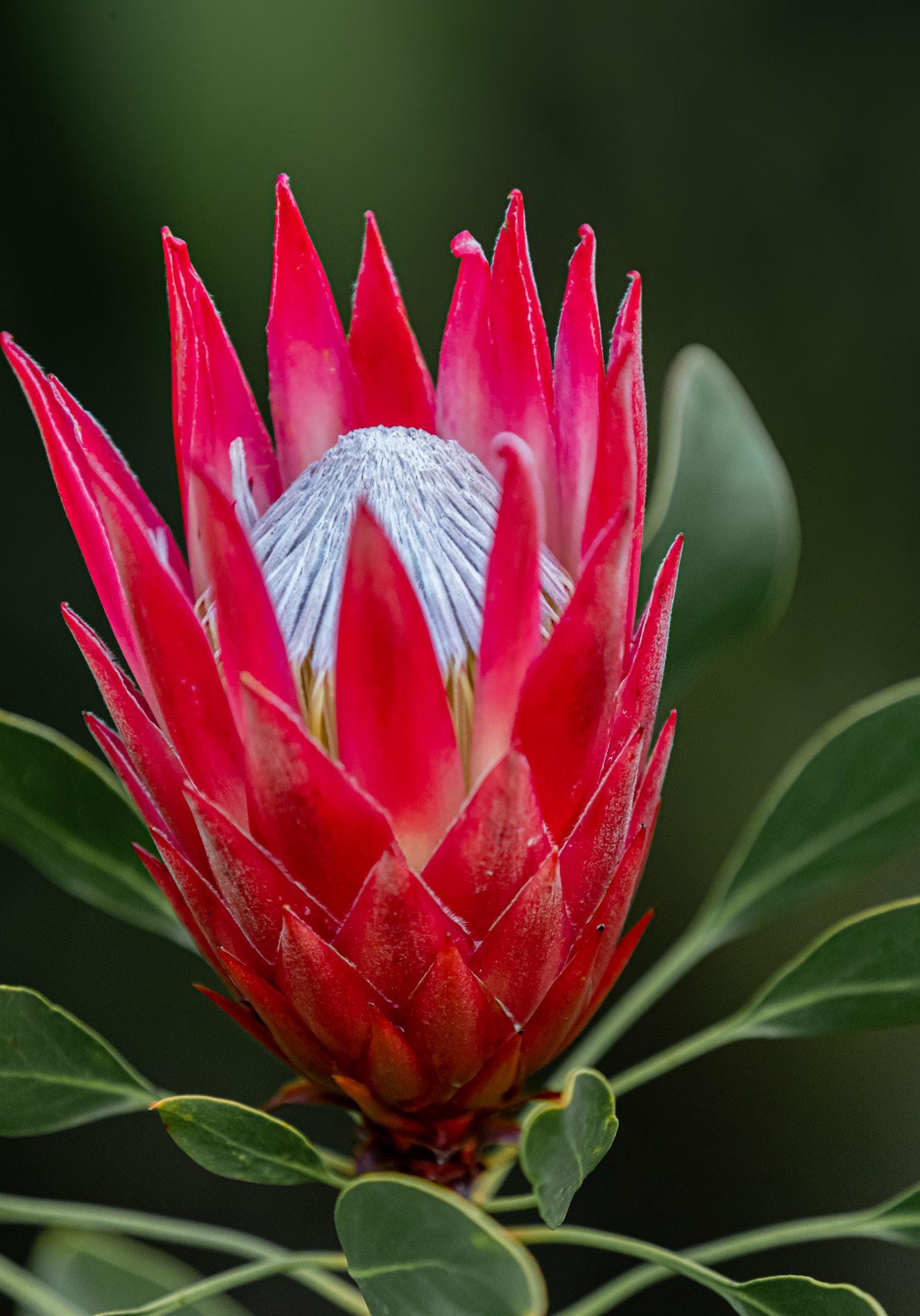
South Africa’s Fynbos
cut and dried flowers trade performance
Vanessa Barends-Jones
Climate Change and its potential effects on animal production: Local studies on sheep and beef cattle to mitigate Impact
Tertius Brand
Heat stress in sheep: The potential of natural tree shade provision and breed selection as mitigatory measures
Kudakwashe Mafunga, Tertius Brand, Cornelius Nel and Schalk Cloete
by Vanessa Barends-Jones1 1Macro and Resource Economics, Western Cape Department of Agriculture

The cut flower industry is a multimilliondollar industry, with a wide variety of flowers and thousands of species cultivated and found in nature (NetnouNkoana & Eloff, 2012). Production of cut flowers is divided into non-indigenous1 (e.g. roses, chrysanthemums), indigenous,2 (e.g. proteas, Leucospermum) and flowers grown from seeds and other flowers (e.g. sunflowers, asters, delphinium) (Louw, 2021 & Cape Flora SA, 2016).
Given that South Africa (SA) is in the southern hemisphere, SA has a seasonal advantage in exporting cut flowers, therefore, meeting the demand of the northern hemisphere markets when their season changes (Duffree, 2018). The fynbos biome is predominantly found in the Western Cape and to a lesser extent in the Northern Cape and the Eastern Cape regions of South Africa. Fynbos flowers are often harvested for their unique appearance and long shelf-life. There is demand for these flowers on the domestic and international markets. This article presents an overview of SA’s fynbos indigenous flowers trade performance. Starting with a brief background of the fynbos biome in the next section.
1 Non-indigenous means flowers that are not naturally found in a specific area or country. These flowers originate from another place/country and often require a lot of care to grow.
2 Indigenous means flowers that are found in a specific area or country.
South Africa is known for its rich biodiversity and has 20 456 indigenous vascular plant taxa recorded, where 13 265 are internationally recognised. Only a few are economically utilised and sold as cut flowers (Netnou-Nkoana & Eloff, 2012). The success of the flower industry is highly dependent on the uniqueness of the product, for example, proteas and other fynbos species that are known for their exotic qualities and are infiltrated into the “niche markets” (Netnou-Nkoana & Eloff, 2012). The fynbos species are part of the
fynbos biome, one of nine biomes in SA, which is found in the Cape Floral Kingdom. It is one of the six Floral Kingdoms in the world and is the smallest. The Cape Floral Kingdom is the only Floral Kingdom that exists in only one country and has a plant species number of 8 700, where 68% of these plant species are found in the Cape Floral Kingdom, which is in the Western Cape (Mucina, et al., 2005).
Figure 1 below illustrates examples of the types of flowers SA is contributing to the international cut flower industry.

3 1A - Protea cynaroides white cultivar; 1B - Protea cynaroides “Madiba”; 1C - Protea “Sylvia”; 1D - Leucospermum “Rigoletto”; 2A - Leucadendron “Buyani”; 2B - Leucadendron (pot plant type); 2C – Orothamnus zeyheri; 2D – Mimetes hirtus; 3A – Nerine cultivars; 3B – Clivia miniata; 3C – Agapanthus praecox; 3D – Crocosmia X crocosmiiflora; 4A – Disa uniflora; 4B – Eucomis autumnalis; 4C – Gloriosa superba; 4D – Rhodohypoxis baurii
According to SAFEC (2014), the flower industry is labour-intensive and is estimated to employ 10 persons per hectare. For exports, global and local, fresh-cut and dried cut flowers were the categories used. Figure 2 shows the export values for freshcut and dried flowers. Fresh-cut flowers performed better than dried flowers on the global export markets and were valued at R85 billion compared to R10 billion for dried flowers in 2023. Focusing on South Africa,
fresh-cut flowers also performed better than dried flowers on the export markets and were valued at R932 million compared to R98 million for 2023. The South African market share for 2023 is 1% for fresh-cut flowers and 0.9% for dried flowers.
Year-on-year growth shows that fresh-cut flowers had positive growth globally (14%) and for SA (22%), while the growth was negative for dried flowers, globally (-5%) and for SA (-5%).


4 HS060319 - Fresh cut flowers and buds, of a kind suitable for bouquets or ornamental purposes (excl. roses, carnations, orchids, chrysanthemums and lilies)
5 HS060390 - Dried, dyed, bleached, impregnated or otherwise prepared cut flowers and buds, of a kind suitable for bouquets or ornamental purposes
Figure 3 indicates the top 10 importing countries for South African fresh-cut flowers. The figure also compares 2013 to 2023 and shows how the market share has changed. The major changes are the Netherlands’ market share increasing from
35% to 47%, China’s share increasing from 0.3% to 11% and Germany has a market share of 1% in 2013 compared to a market share of 5% in 2023. A major decline in market share was in the United Kingdom, from 18% to 4%.
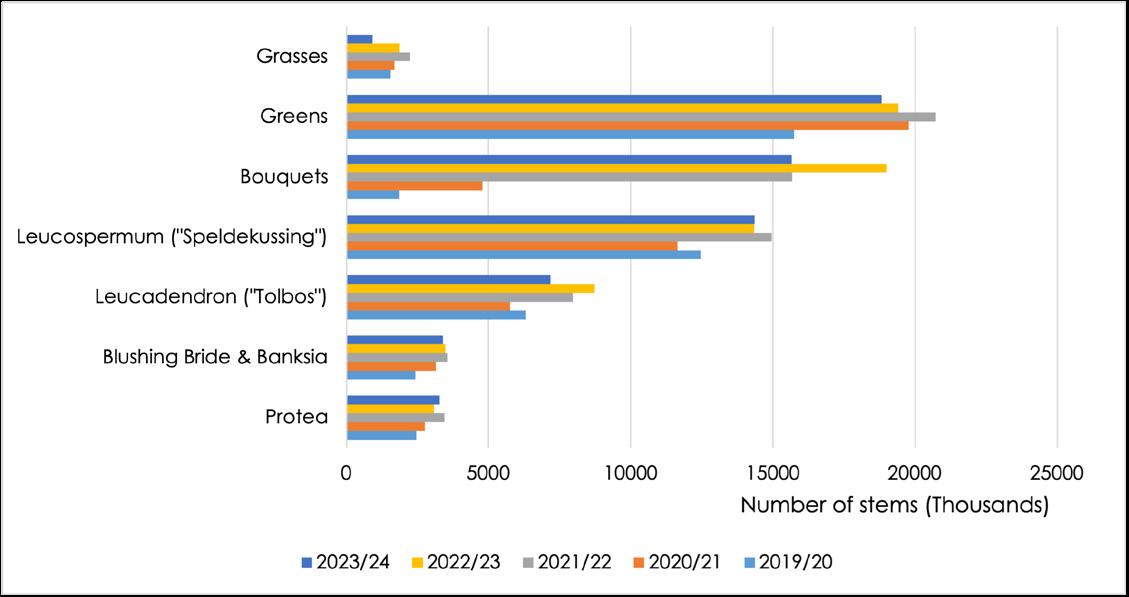
Figure 4 presents the stems of the different species from South Africa being exported globally. The figure shows that more greens, bouquets and Leucospermum are being exported for the periods looked at. For the 2023/24 period 30% greens were exported, followed by 25% bouquets and 23% Leucospermum
4. Concluding remarks
The fynbos biome has a variety of species that are harvested for domestic and trade purposes. South Africa trades more in freshcut flowers, and in 2023 exports were worth R932 million and dried flowers R98 million in the same year. SA’s fynbos fresh-cut flowers account for 1% of the global fresh-cut flower market share. The Netherlands, China and Japan are the three leading importers of fresh-cut flowers from SA.
The cut flower industry is important for the economy as it is seen as one of the
key job creators due to the industry’s labour intensity, as mentioned, 10 people per hectare (SAFEC, 2014). SA also has a seasonal (southern hemisphere supplying the northern hemisphere) and geographical advantage (especially for the fynbos flowers, which are only grown in SA), which are also key for our economy.

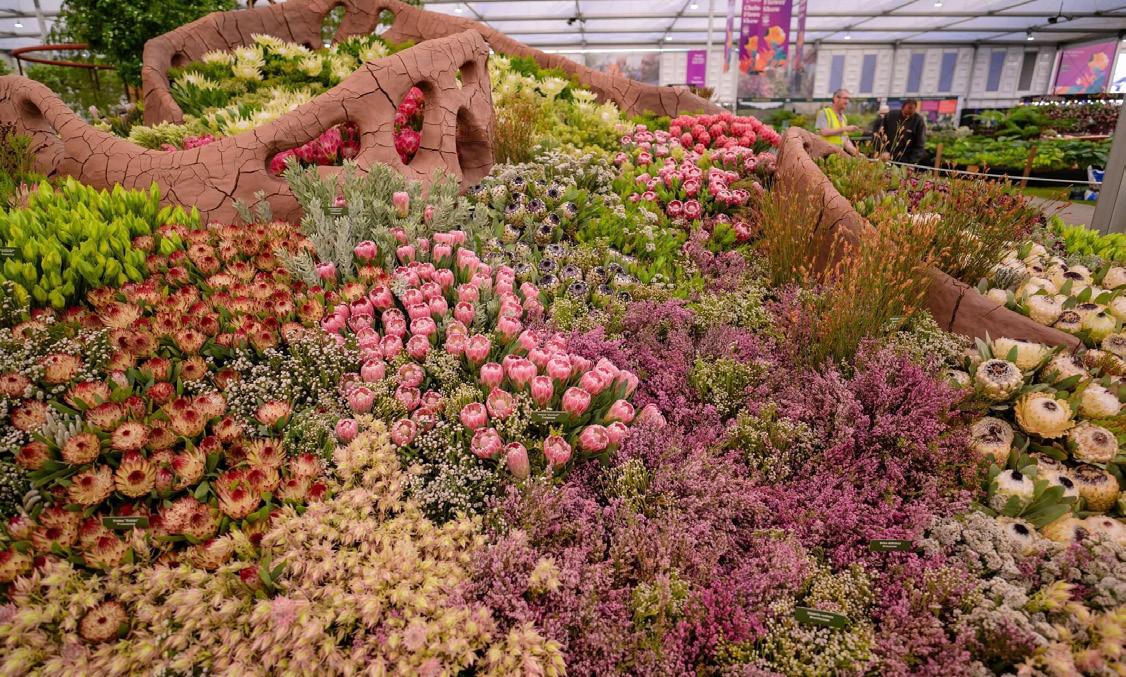
South Africa's flora shines on the world stage
South Africa’s success at the 2024 RHS Chelsea Flower Show highlights the country’s strength in the global freshcut flower market, particularly with its unique fynbos and protea varieties. These indigenous blooms continue to
References
capture the world's attention, boosting South Africa's floral export industry.
Watch this!
Scan the QR code or visit shorturl.at/hwhnM to watch the video: ‘Chelsea Flower Show 2024 Awards South Africa’. Published by Leon Kluge.
Cape Flora JMF. (2016). SA Exports and Estimates. Cape Town: Cape Flora JMF. Cape Flora SA. 2024. Statistics and Reports. [Online] Available: shorturl.at/brknb [Accessed 17 May 2024].
Duffree, A. 2018. South Africa has deep roots in floriculture. [Online] Available: shorturl.at/AXI6R
Louw, M. (2021). The Flower Industry in South Africa. Retrieved from South African Online: shorturl.at/yiEtu
Netnou-Nkoana, N., & Eloff, J. 2012. The South African floricultural industry and the plant breeders' rights act: A short review. Pretoria: Department of Agriculture, Forestry and Fisheries.
Reinten, E., Coetzee, J., & van Wyk, B. (2011). The potential of South African indigenous plants for the international cut flower trade. South African Journal of Botany, 934-946.
SAFEC. 2014. South African Flower Export Council. SAFEC.
TradeMap. 2024. RSA Regional Trade HS6 digits. [Online] Available: shorturl.at/r5oBK [Accessed 17 May 2024].
For more information, contact Vanessa Barends-Jones: vanessa.barends@westerncape.gov.za
Tertius Brand1,2
1 Directorate for Animal Sciences, Department of Agriculture, Private Bag x1, Elsenburg 7607
2 Department of Animal Science, Stellenbosch University, Stellenbosch 7600

EEstimates suggest that the global population will reach 8.5 billion people by 2030 (EAAP, 2019). Approximately 16% of the global population will live in Africa by 2030, and nearly 25% will reside in Africa by 2050 (EAAP, 2019). Concurrently, climate change projections for the 21st century indicate a 2.8ºC increase in global temperatures (EAAP, 2010), along with heightened climate risks, including droughts and storms.
A long-term study already done by the Department of Agriculture in 1983 on the occurrence of periodical droughts in South Africa revealed that the country experiences severe droughts approximately once every five years. In regions with long-term annual rainfall of less than 400mm, they found that only two out of three years receive sufficient rain. In contrast, areas that typically receive more than 600mm of
rain annually experience adequate rainfall in six out of seven years (Department of Agriculture, 1983). A recent review by Beraki (2019) predicts that the southern African region, particularly South Africa, is expected to become generally drier, with an increase in dry spells and droughts.
It is estimated that the total sales of agricultural products in South Africa amounted to R317.6 billion in 2019. This included the contribution by livestock (48%), followed by horticulture (27%), field crops (19%), and other products (4%) (Agricultural Survey, 2019). The need to produce more food for a rapidly growing population is creating pressure on animal production and crops. Pressure on animal and crop production must be managed to ensure that potential negative impacts on the environment can be minimised or mitigated as far as possible.
In the realm of agriculture, the shifts due to climate change may lead to reduced animal as well as crop production in rain-fed regions, such as South Africa, potentially resulting in food shortages in sub-Saharan Africa in the long term (EAAP, 2010). A critical consequence of climate change is the increasing pressure by retailers, investors and consumers on the meat and dairy industries to limit greenhouse gas emissions. It is evident that feeding the rapidly growing global human population in this changing and volatile environment necessitates the sustainable intensification of agriculture and animal production, involving increasing output per unit of input by making more efficient use of available resources.
The sustainability of food systems poses one of the most significant challenges facing humanity in the years to come. Local food networks are expanding worldwide, yet there is a lack of comprehensive information regarding their respective carbon footprints in South Africa. Recent studies, for example in Italy (studies by Bernabucci and Lacetera, 2019), pointed out that climate change is expected to have a predominantly negative impact on livestock production, as well as on the health and welfare of farm animals. The adverse effects on animal health and welfare will result from a combination of changes in air temperature, precipitation, the frequency
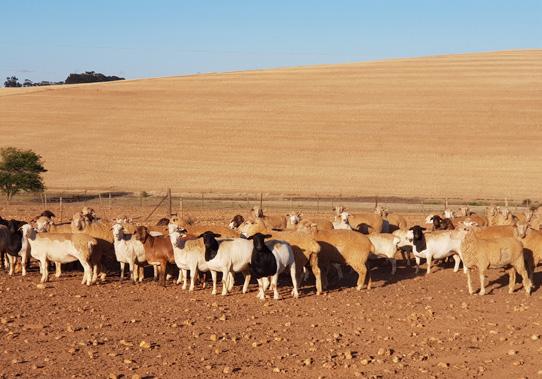
and severity of extreme weather events, and can manifest both directly and indirectly.
Climate change consequences are primarily associated with elevated temperatures and the increased occurrence of heatwaves, which can negatively affect livestock health.
Depending on the intensity and duration of heat stress, it can disrupt metabolic processes, lead to oxidative stress, weaken the immune system, and result in infections and death (Lacerta, 2019). The importance of developing and implementing methods that link local climate data to decreases in production and increases in disease occurrences is underscored according to these experts.
To adapt to climate change, animal production systems in South Africa must also become more efficient, and unnecessary losses should be reduced. Recent studies involving sheep and cattle at Elsenburg to address climate change include a study by Shannon Steyn, who completed her master’s study at the Stellenbosch University in 2022 on the response of lambs and ewes to changes in ambient climate owing to climate change. Her research indicates that certain sheep breeds may be better suited to higher environmental temperatures. Her study is currently succeeded by a study by Kuda Mafunga (PhD, Stellenbosch University), who will work on the 10 most abundant sheep breeds in South Africa managed at the Langgewens Research Farm near Moorreesburg and he will try to evaluate the differences in the breeds’ physiological responses due to heat stress. He will simultaneously look at the effect of tree shade on the heat stress in lambs born in autumn.

An ongoing study by Pieter Theron (PhD, Stellenbosch University) is focusing on the development of a climatelinked production prediction model for extensive South African sheep farming enterprises. He will use historic data collected both in the Western and Northern Cape. A study completed by him on the shearing of feedlot lambs in summer months revealed that shearing did not significantly affect mean weight, daily feed intake or feed conversion, but unshorn lambs exhibited higher average
Ongoing studies focus on the development of a climate-linked production prediction model for extensive South African sheep farming enterprises.
respiration rates compared to shorn lambs, while both groups showed similar surface temperatures and identical rectal temperatures. The results indicated that increased respiration sufficiently regulated thermoregulation to prevent heat stress from occurring more frequently than in shorn animals. Consequently, shearing of feedlot animals at this environmental temperatures and age as tested in his studies yielded no production benefits for producers and only marginally improved thermal tolerance.

In a long-term study, two cattle breeds are equipped with new electronic animal monitoring systems to determine the movement and behaviour of cattle with regard to availability of vegetation, vegetation types, daily climate, available water points, and a range of other factors.
In a long-term study, two cattle breeds managed at the Nortier Research Farm near Lambert’s Bay will be equipped with cattle collars with an Ultra High Frequency Long Range Global Positioning System (LoRa (GPS/ UHF)) as well as SenseHub BeefR, a new
electronic animal monitoring solution from Allflex Livestock Intelligence™. These systems will allow researchers to analyse data on the movement and behaviour of cattle with regard to data on vegetation, climate, available water points, and a range of other factors.
Part of the data collected in this study will be used by Wilmie Hough for a master’s study at the Stellenbosch University. These current projects managed by Elsenburg as well as experts from other institutions in South Africa in collaboration with experts from abroad align with global climate issues and the recommendations made by experts regarding the impact of climate change on future animal production. Certain sheep and cattle breeds or lines may possess unique adaptive traits, such as disease resistance, heat tolerance, thirst tolerance, and the ability to produce on lowerquality feed, making them more productive under harsh conditions. This, in collaboration with precision agriculture and especially precision livestock farming, may be a suitable tool to enable local agricultural producers to adapt their farming practices to climate change and compete in the modern global economy and to solve production constraints while minimising waste and costs. AP
Agricultural Survey, 2019. Stats SA. Pretoria, South Africa.
Ukutshintsha kwemo-yezulu nemiphumela ekunokuyibangela kweZolimo
Uqikelelo lubonakalisa into yokuba ngomnyaka wama 2030, inani labantu abaphila kwihlabathi liphela lobe selifikile kwi 8.5 lezigidi-ngezigidi zabantu. Ngomnyaka wama 2030, limalunga neshumi elinesithandathu ekhulwini inani labantu abobe bephila kwihlabathi liphela, nabazakuba kwi Afrika, ze lisondele kuma 25% inani labantu abobe bephila kwi Afrika ngowama 2050. Kwangaxesha-nye, uqikelelo ngokwamanani malunga nokutshintsha kwemo-yezulu kwiminyaka yenkulungwane yama 21, lubonakalisa ukwanda nge
2.8oC kulo lonke ihlabathi, kwakunye nokuphakama komngcipheko kwimoyezulu, kuquka imbalela neenkqwithela. Ngokwakwezolimo, iinguquko ezinokubangelwa lutshintsho kwimo-yezulu zingakhokelela ekuncipheni kwemfuyo nemveliso kwizityalo kwiingingqi ezifumana imvula, nezinje ngo Mzantsi Afrika, nekunokuthi kumaxesha azayo iphimisela iziphumo zemeko yokunqongophala kokutya kumazwe akumazantsi entlango i Sahara kwi Afrika. Ngoko ke, ukuzinziswa kweendlela zokuveliswa kokutya kuyeminye imingeni nowakhe wamkhulu nezakujongana noluntu kule minyaka izayo. Ngelokuziqhelanisa nokutshintsha kwimo-yezulu, kufuneka iindlela zokuveliswa kwemfuyo kuMzantsi Afrika zibe zezinemfezeko, ze kuncitshiswe iilahleko ezingeyomfuneko ukuze simelane nemiphumela yexesha elizayo nenokubangelwa kukutshintsha kwemo-yezulu.
Beraki, 2019. Green Book. The impact of climate change on drought. Technical Report. CSIR, Pretoria, South Africa.
Bernabucci, U., 2019. Climate change: Impact on livestock and how can we adopt. Animal Frontiers Vol 9, No 1, January 2019. Department of Agriculture, 1983. Department of Agriculture, Pretoria, South Africa.
EAAP, 2010. Understanding global climate change and its possible impact on agriculture. 61st EAAP Conference, Heraklion, Greece. August 2010.
EAAP, 2019. Invited speakers on population growth. 70th EAAP Conference, Ghent Belgium. Lacetera, N., 2019. Impact of climate change on animal health and welfare. Animal Frontiers Vol 9 No 1, January 2019.
For more information, contact Prof. Tertius Brand: tertius.brand@westerncape.gov.za
by Kudakwashe Mafunga1, Tertius Brand1,2, Cornelius Nel1,2 and Schalk Cloete1
1 Department of Animal Sciences, Stellenbosch University, Private Bag X1, Matieland, 7602, South Africa
2 Directorate: Animal Sciences, Department of Agriculture, Western Cape Government, Private Bag X1, Elsenburg, 7607, South Africa.

IIn terms of numbers, sheep are the dominant ruminant species (21.9 million) in South Africa. Sheep farming systems can be found all over South Africa, and they are considered more easily adaptable to the varied environments and climatic conditions (Cloete & Olivier, 2010; Cottle, 2010) compared to other ruminants. However, at high temperatures and high radiation, even the most tolerant breeds have difficulty in managing heat loss and, hence, regulating their internal temperatures.
The expected upward trend in temperature thus poses a threat to sheep production and the livestock industry.
The Intergovernmental Panel on Climate Change (IPCC) Sixth Assessment Report indicated that the planet’s temperature is projected to be between 1.2 to 3°C higher than the pre-industrial temperature level by the year 2060 (IPCC, 2021).
Southern Africa, of which most of the areas are already classified as warm and dry, is particularly exposed and vulnerable to changes in climate. Generally, the length of the cold spell has declined, whilst there is a significant increase in the duration of the warm spell in most parts of South Africa, with projections showing such conditions to persist in the future. With temperatures in Southern Africa rising at double the global average rates, livestock production and welfare in this area is expected to be particularly affected. Accordingly, research on animal welfare related to thermal comfort has intensified in recent years in an attempt to minimise the negative effects of climate on animal production in the tropics. To produce animals in a socially acceptable way, ethical issues pertaining to animal welfare must be seriously considered within any breeding system.
Sheep production is concentrated in the arid to semi-arid parts of South Africa, mostly under the extensive sheep production system (Cloete & Olivier, 2010).
Animals, particularly those originating from temperate regions, are therefore
vulnerable to heat stress. Heat stress has a wide range of negative effects on small ruminants, including decreased performance in both reproduction and production traits, compromised natural immunity, and increased vulnerability to diseases and death.
Natural shade has the potential of alleviating the challenge of heat stress by modifying the microclimate. The provision of tree shade can be an effective measure to alleviate heat stress in sheep during extreme summer and autumn conditions. It provides a natural protective barrier against direct radiation from the sun, and aids in regulating ambient temperatures.
Preliminary results from an ongoing study at Elsenburg Research Farm showed that lambs of the South African Mutton Merino (SAMM) and Dormer breed kept under paddocks with access to shade had lower respiration rates and rectal temperature compared to sheep kept in paddocks without access to shade (Cloete et al., 2021).
The preliminary results from the autumn 2017 and 2018 lambing seasons also showed that tree shade has a moderating effect on microclimate, resulting in lower maximum daytime and higher minimum night-time temperatures.
Tree shade can enhance animal welfare by alleviating the effect of high temperatures in the lambing season. Besides heat stress alleviation in livestock, trees have the capacity to mitigate climate change by acting as natural air purifiers and carbon sinks. They absorb carbon dioxide from the atmosphere through photosynthesis, storing carbon in their biomass and soils. This process helps reduce greenhouse gas concentrations and mitigate the impacts of climate change.

In cases where no shade is available, making use of the more tolerant breeds can be an alternative strategy. Research conducted elsewhere has demonstrated that different sheep breeds have varying tolerance levels for heat stress (McManus et al., 2016). In an ongoing study examining variations in heat stress tolerance in sheep, 10 prominent South African sheep breeds (Merino, Dohne Merino, SA Mutton Merino, Dormer, Île-de-France, Dorper, Meatmaster, Damara, Black-headed Persian, and Namaqua Afrikaner) will be equipped with ruminal temperature loggers to monitor core temperature. Additionally, respiration
References
rate, rectal temperature as well as panting scores will be monitored to correlate them with environmental conditions. These results will help identify the optimal temperature range for each breed to maintain body temperature. This research will offer valuable insights for scientists and farmers to identify sheep breeds that can tolerate specific conditions with minimal heat stress.
Natural tree shade and strategic breed selection can mitigate heat stress in sheep. However, further research is needed to better understand the long-term effectiveness of these measures. AP
Cloete, S. W. P., Muller, A., Steyn, S., van der Merwe, D. A., Nel, C. L., Cloete, S., Kruger, A. C. M., & Brand, T. S. 2021. The effect of tree shade on ambient conditions and heat stress indicator traits of new-born South African Mutton Merino and Dormer lambs: Preliminary results. Journal of Thermal Biology 99 shorturl.at/ldgQz
Cloete, S., & Olivier, J. 2010. South African Sheep and Wool Industries. International Sheep and Wool Handbook, Editor DJ Cottle, 95–112. Nottingham University Press. IPCC. 2021. Summary for policymakers (V Masson-Delmotte, P Zhai, A Pirani, SL Connors, C Péan, S Berger, N Caud, Y Chen, L Goldfarb, MI Gomis, M Huang, K Leitzell, E Lonnoy, JBR Matthews, TK Maycock, T Waterfield, O Yelekçi, R Yu, & B Zhou, Eds.). Cambridge University Press, Cambridge, UK and New York, USA.
McManus, C., Dallago, B. S. L., Lehugeur, C., Ribeiro, L. A., Hermuche, P., Guimarães, R. F., Carvalho Júnior, O. A. de, & Paiva, S. R. 2016. Patterns of heat tolerance in different sheep breeds in Brazil. Small Ruminant Research 144, 290–299 shorturl.at/ZJKtf
For more information, contact Nelius Nel: nelius.nel@westerncape.gov.za
The Western Cape Department of Agriculture provides a wide range of development, research and support services to the agricultural community in the Western Cape.
This A-Z booklet was compiled to serve as an easy-to-use reference guide to the 122 services of the department. scan to read

This A-Z booklet was compiled to serve as an easy-to-use reference guide to the 122 services of the department.

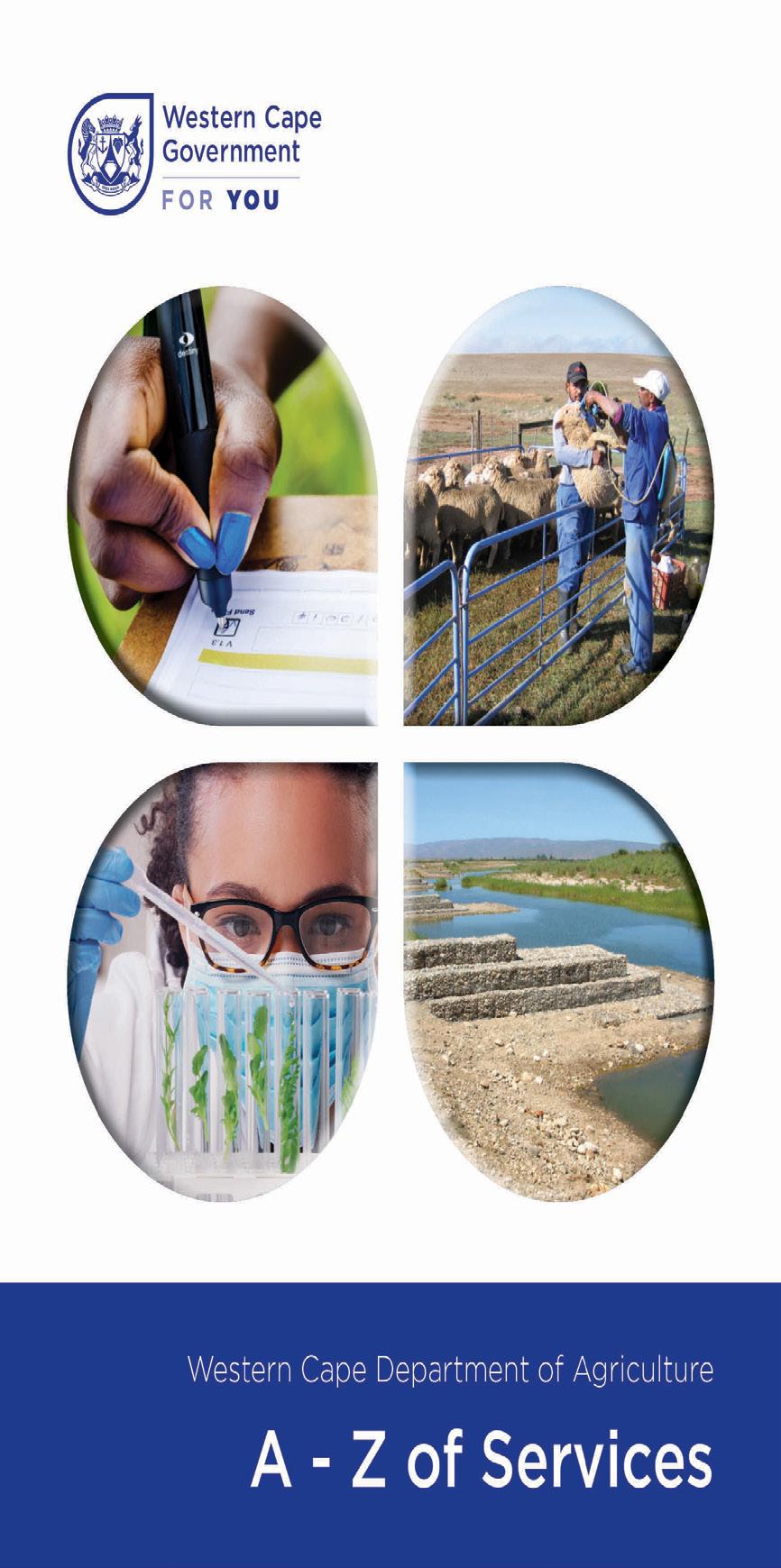



Subscription
For free subscription to this quarterly magazine, please submit your details to Magrieta de Lange. Tel: 021 808 7613
Email: doa.info@westerncape.gov.za
Contact us
Western Cape Department of Agriculture
Tel: 021 808 5111
Email: doa.info@westerncape.gov.za
Web: www.elsenburg.com
Is a quarterly magazine, distributed to subscribers at no charge by the Western Cape Department of Agriculture. You can also read your copy online and subscribe at www.zinio.com/za/agriprobe-m40279
Printing
CTP Printers (Cape Town) Tel: 021 929 6200
Digital edition
Available on the ZINIO newsstand Web: www.zinio.com
Packaging
Stellenbosch Work Centre for Adults with Disabilities
Tel: 021 887 8688
Email: jjja@sun.ac.za
Don’t forget to tune into RSG Landbou every Friday morning at 05:25am and on Saturdays at 11:45am. Listen to the highly informative programmes on the Western Cape Department of Agriculture and the Agricultural Sector in general.
If you miss it on the radio, you can also listen to the programmes of the week on www.elsenburg.com/rsg-landbou/